26 min read • Organization & transformation, Strategy
Reimagining India’s supply chain
A bold vision for 2030
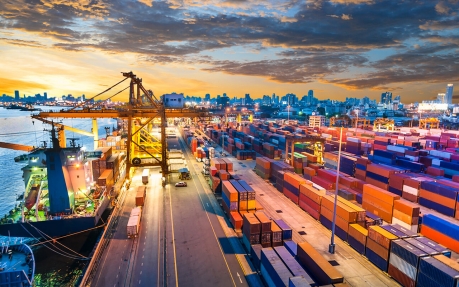
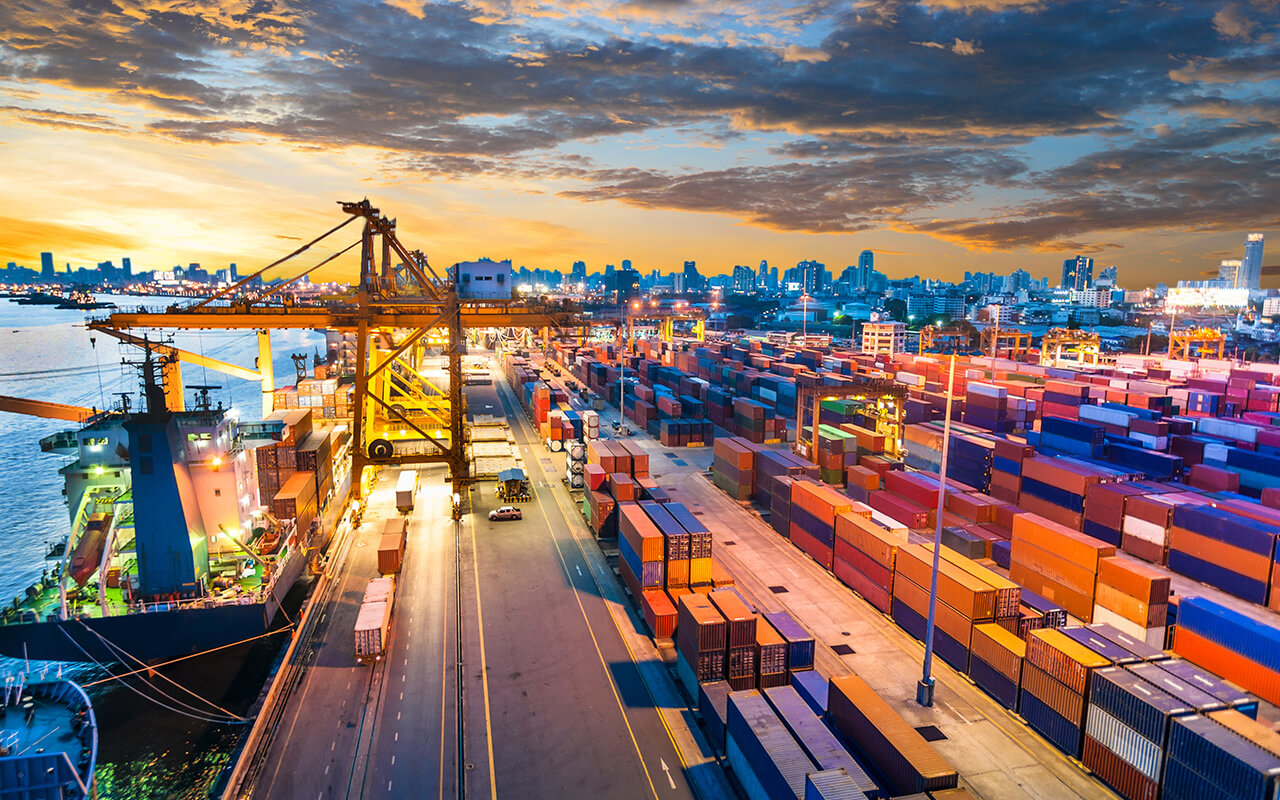
Foreword
India’s supply chain and logistics sector is one of the largest globally. The sector has the potential to grow multifold.
India needs to effectively bridge the competitiveness gap of USD 180 billion vis-à-vis the supply chains of advanced nations and become a leading player globally.
At the CII Supply Chain Leadership Conclave held on September 11, 2020, supply chain experts from the CPG and Pharmaceuticals presented their insights on the theme, “Supply Chain Transformation for Efficiency and Capability”. The conclave had the participation of over 270 delegates from the supply chain and logistics sector, including CEOs, Directors, experts and senior leadership of various organizations.
Deliberating on the scenario of India’s current supply chain, the Conclave discussed the need to build a technology-enabled, integrated supply chain that ensured visibility and efficiency and would create a flexible and agile process with seamless experience for customers.
To help achieve this goal, the report outlines a Vision 2030 for the Indian Supply Chain with focus on logistics costs, optimizing the logistics modal mix, digitizing 80-90% of supply chain operations, developing omni-channels and moving towards green supply chains. Enhancing skill development is also a key imperative.
The report has been developed by Confederation of Indian Industry (CII) and Arthur D. Little to set a bold ‘Vision 2030’ for the Indian supply chain and identify collaborative opportunities between Industry and State & Central Governments in achieving this vision.
We are certain that this report will help stakeholders build a globally competitive supply chain, thereby facilitating the transition for India’s evolution as a leading economy in the world.
— Mr CK Ranganathan, Deputy Chairman, CII Southern Region & Chairman & Managing Director, CavinKare Pvt. Ltd.
Preface and acknowledgements
The CII Supply Chain Leadership Conclave (CPG & Pharma), held on September 11, 2020, marked the beginning of an initiative to transform India’s supply chain in line with a bold vision for 2030. Arthur D. Little is pleased to be a part of this effort, starting with its role as CII’s technical partner for the conference.
This report describes the perspective gained through presentations by top supply chain experts and discussions with leaders in the industry. It aims to set the aspirations for the industry and lay down a roadmap to achieve Vision 2030.
We would like to acknowledge the insights and support provided by many in developing this report.
First of all, we are grateful for the unconditional support of CII Southern-Region for its help with coordinating and conducting the conference. We thank Jeanne Subramaniam for her editorial support.
Finally, we thank all the conference speakers for their expertise, commitment and generosity with time and information.
— Barnik Chitran Maitra, Managing Partner, India and South Asia, Arthur D. Little
Executive summary
It is hard to understate the importance of supply chain efficiency for large and growing economies, particularly India. An efficient and sustainable supply chain management system is one of the key factors for economic growth. An effective supply chain directly translates into competitiveness across economic sectors through lowered input costs.
India’s supply chain and logistics sector is one of the largest globally, with a logistics industry of USD 215 billion and growing at a CAGR of 10.5 percent. However, despite its size and criticality to economic growth, India’s supply chain is marred by an unbalanced logistics modal mix, high indirect costs, poor infrastructure, fragmented networks, and lack of technology adoption.
The COVID-19 pandemic has accentuated supply chain weaknesses, with nearly 75 percent of companies worldwide experiencing disruptions. Worse still, most companies have reported lack of any contingency plan to deal with a problem of this magnitude.
One of the biggest revelations of the pandemic for this sector is the urgent need to leverage disruptive technologies for greater resilience. In India, the pandemic has accelerated digital adoption on the demand side. This stemmed from the unprecedented demand faced by online grocery providers, which forced them to limit access for existing consumers in April and May 2020. These disruptive events pushed decision-makers to reimagine the country’s supply chain management.
This is the moment for the Indian supply chain and logistics sector to reconfigure and redesign supply chains with greater thought to disruptive technologies and risk management, especially considering the resilience required in the consumer-packaged goods (CPG) and pharmaceuticals sectors.
With this background, this report describes the key issues discussed at the CII Supply Chain Leadership Conclave held on September 11, 2020, and the steps needed to achieve Vision 2030 for the Indian supply chain. They can be summarized as follows:
- The logistics cost in India stands at 14 percent of GDP, compared to the global average of approximately 8 percent. This creates a competitiveness gap of USD 180 billion for India, which will increase to USD 500 billion by 2030.
- Supply chains are transforming globally by adopting Industry 4.0 trends. Organizations are building agile networks, using disruptive technologies, ensuring end-to-end visibility, and moving from risk mitigation to risk management.
- Several emerging technologies are available to enhance supply chain resilience. In mature economies, the use of artificial intelligence, blockchain, and the Internet of Things (IoT) has proved valuable.
- To make India’s supply chain competitive, efficient, and resilient, we propose a Vision 2030 that aims to pare logistics cost to 7-8 percent of GDP, optimize the logistics modal mix, digitalize 90 percent of supply chain operations, develop omni-channels, move towards green supply chains and enhance skill development.
1
An uncompetitive supply chain
The CII Supply Chain Leadership Conclave opened up a plethora of themes and ideas raised by supply chain experts in the CPG and pharmaceutical industries. The initiatives identified in their addresses match the imperatives for India in building a globally competitive supply chain.
Logistics costs in the Indian supply chain amount to almost USD 400 billion, or 14 percent of GDP.[1] A comparison with global peers shows that logistics costs amount to 8-10 percent of GDP in the US and Europe, and 9 percent in China. The global average is close to 8 percent of GDP, which reveals a competitiveness gap of USD 180 billion for India. India ranked 44 in the World Bank Logistics Performance Index, last released in 2018, far behind the US at 14 and China at 26. Other South-Asian countries, such as Thailand and Vietnam, also have high logistics costs. These countries’ costs reach 14 and 16-17 percent of GDP, respectively. However, they fare slightly better than India on the logistics performance index, with Thailand at 32 and Vietnam at 39.
Any improvement of India’s performance will hinge on how well we tackle barriers to competitiveness that impede the supply chain’s operation and growth.
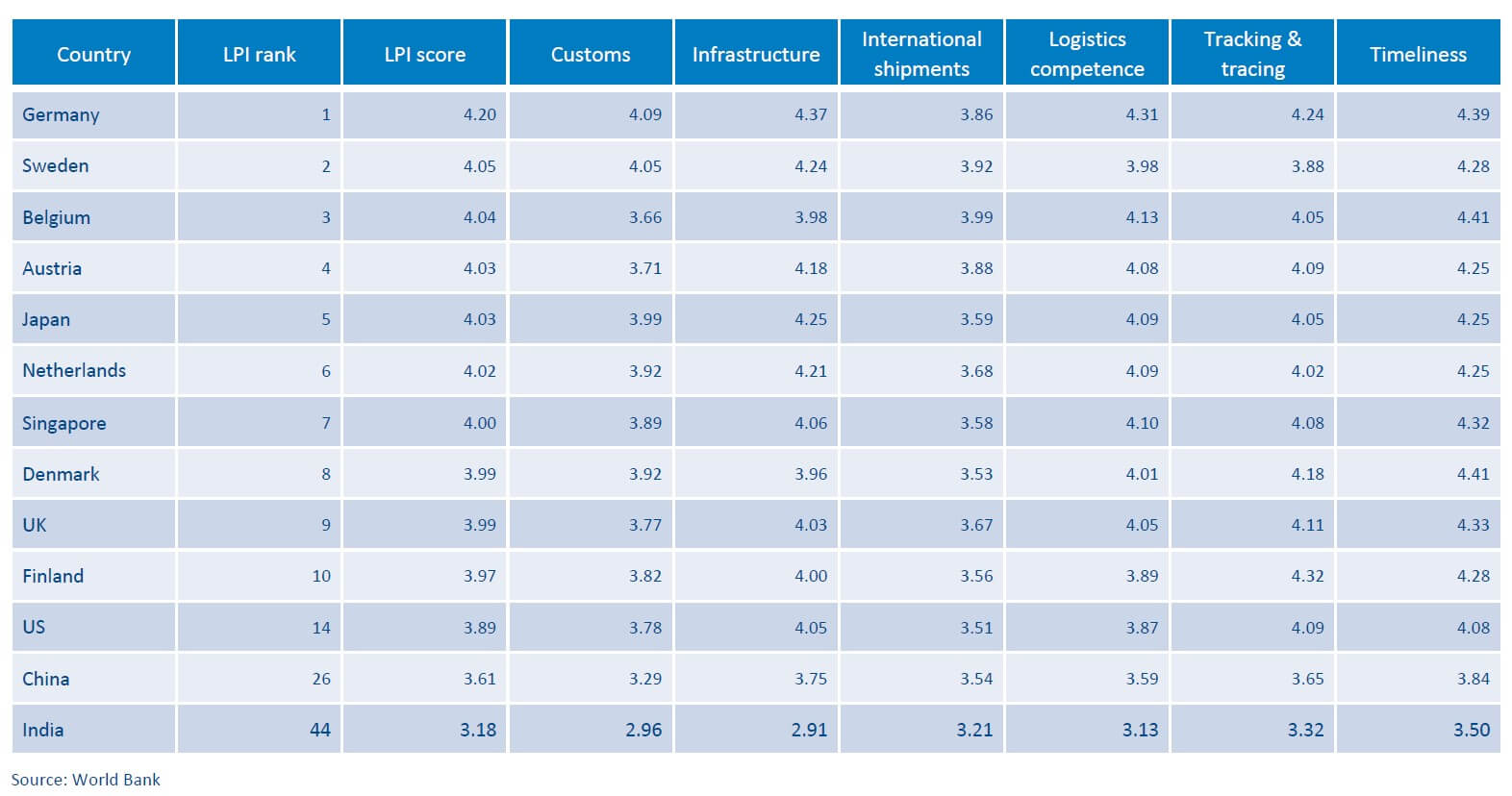
Barriers to competitiveness
India’s supply chain has remained well below global standards because of the drawbacks and certain inefficiencies that plague it. These can be summarized as follows:
- An unbalanced logistics modal mix: A modal mix heavily skewed towards transportation by road is at the root of the unwarranted logistics costs. Transportation represents approximately 40 percent of logistics costs, which amount to 6 percent of GDP. Transportation by road makes up the lion’s share of this cost, at about 64 percent, followed by rail at 30 percent and waterway and air transport at 5 and 1 percent, respectively. This heavy dependence on the road networks, combined with poor transportation infrastructure, makes transportation costs balloon. Currently, the per-ton-km cost of transportation via the road network is almost double that of rail and waterways, at Rs 2.58/ton-km, compared to Rs 1.41/ton-km for rail and Rs 1.06/ton-km for waterways. India’s rail and sea network are highly under-utilized due to lack of supporting infrastructure.
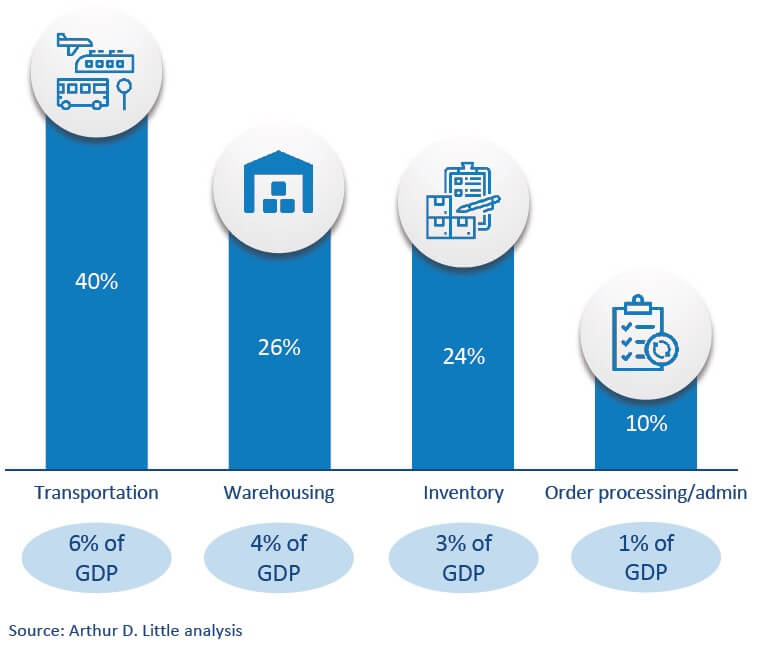
- High indirect or “hidden” costs: Indirect logistics costs in India are four times the average of those in developed countries. The main reasons are excessive layers in distribution channels and inventory mismanagement. Inadequate demand forecasting due to lack of technology adoption leads to inventory mismanagement. It also leads to high inventory carrying costs, which include costs for holding and storing unsold goods. These costs alone amount to 15-25 percent of inventory costs (4-6 percent of total logistics costs), which amounts to USD 120 to 180 billion.
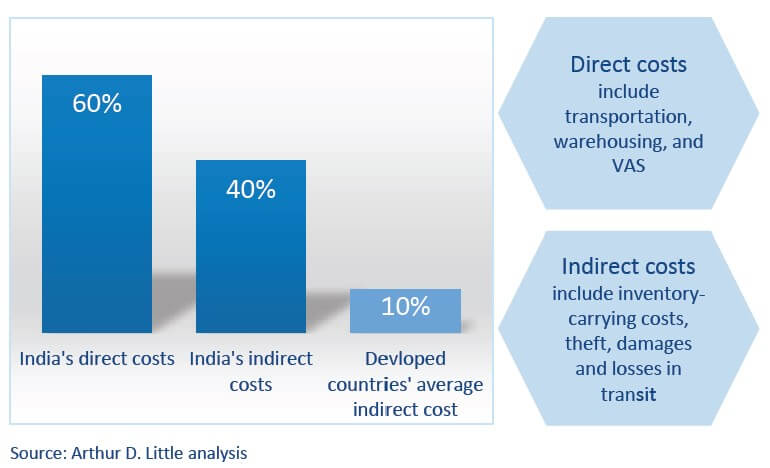
- Poor-quality infrastructure: India has the second-largest road network globally, which totals 5.5 million kilometers, yet national highways account for less than 2.7 percent of the total network. This puts a severe strain on the national highway network, which carries about 40 percent of the road traffic. India also has one of the largest rail networks in the world, spread over 1.2 lakh kilometers. However, the average speed of freight trains in India is 24-25 kmph, compared to 38-40 kmph for those in the US and China. Furthermore, India has a shortage of warehousing space. Storing of drugs and perishable consumer goods requires cold-storage facilities. As of 2019, India had a total cold-storage capacity of 226.7 lakh tons (lt), against the required capacity of 350 lt. According to the Indian Council of Food and Agriculture, 30 percent of agricultural produce goes to waste every year due to lack of cold chain infrastructure.
- Limited adoption of the latest technology: The slow adoption of supply chain technology, such as artificial intelligence, blockchain and the IoT, remains a major shortcoming. Organizations globally have adopted the latest technologies to ensure full visibility and real-time information on processes in the supply chain. Lack of digitization, inventory mismanagement and inaccurate demand predictions in the absence of technology contribute in large part to the competitiveness gap between India and its global peers.
- Fragmented logistics (trucking) network: Despite its centrality to economic growth, India’s logistics sector has remained fragmented and unregulated, comprising many local players and no national or regional players that can create end-to-end platforms. The trucking industry is especially unorganized, and marked by non-standard equipment such as pallets and truck dimensions. Only 10 percent of Indian truck operators own fleets above 25 trucks; most others are drivers with single trucks who rely on third parties to handle their orders. With no big players to control the market, businesses at entry level are at a cost disadvantage. The turnaround time for trucks in India is low, at less than 300 kilometers per day compared, to more than 700 kilometers per day in Europe and the US.
- Uneven channel mix for domestic retail and FMCG sales: India’s retail market is dominated by unorganized retail, which amounts to a massive 90 percent of total retail, comprising nearly 12 million kirana stores. Digital/e-commerce platforms account for a minuscule 2 percent of sales, and organized retail just 8 percent. In comparison, countries such as China and the US have much higher shares of organized retail and online sales. These shares reach 56 and 21 percent, respectively, for China, and 76 and 14 percent, respectively, for the US. With so many micro- and small-scale sellers and scattered, barely integrated pathways for moving products, the supply chain has become convoluted.
At the conclave, leaders and experts detailed the improvements needed to make India’s supply chain more competitive. These can be summarized as follows:
- Technology-enabled supply chain architecture: The discussion revolved around making supply chain channels technologically driven. In today’s world, digitization is not an option, but a necessity. We need end-to-end, real-time visibility to enable quick action in case of disruption. The entire supply chain needs to be connected by integrating physical networks with digital technology. The latest technology, such as geo-tagging, auto-capture, and big data, enables collaboration, better forecasting, and traceability along the network, which helps to monitor supply chains. Technology-enabled forecasting helps reduce wastage along the supply chain by allowing organizations to manage demand- and supply-side shocks. Artificial intelligence, blockchain technology, and the IoT will bring breakthrough productivity gains in the supply chain network. Industry stakeholders have already made vigorous attempts at full use of these technologies. Automation in packaging has helped industries reduce the workforce by 20-30 percent, which has curtailed losses due to labor migration. The push due to the pandemic has led to faster adoption of technology.
- Integrating the supply chain network: Building a flexible and agile supply chain requires platforms that integrate the processes involved. The panelists recommended a move towards omni-channel supply chains to provide a seamless experience for consumers, irrespective of the channels used. Simplifying the supply chain will also make it feasible for organizations to function with low inventory. The panelists also suggested a need to integrate supply chain planning with execution to ensure quick response to any disruptions. Organizations will gain from building partnerships of shared assets and services. This will help them reduce costs and create an ecosystem by developing collaborative platforms such as online B2B marketplaces. The norm is not start-ups versus incumbents anymore, but start-ups and incumbents. Kirana shops are a unique feature of the Indian supply chain. Integrating kirana stores digitally has massive savings potential in terms of both costs and time. Orders through e-kiranas can save up to 120 minutes of retailers’ ordering time, which can be used more productively in serving customers.
- Building logistics infrastructure: A major theme at the conclave was improving India’s logistics infrastructure by benchmarking the logistics modal mix and emphasizing the use of electric vehicles (EVs) for last-mile deliveries. Optimizing routes, delivery points, and networks can reduce product damage, which will lead to green supply chains.
- Advocating for enabling policy: The panelists proposed a push for advocating supply chain-friendly policies. Appropriate policy will help improve India’s logistics network and make it globally competitive. The panelists raised the issues of standardization of truck size, reduction in turnaround time, development of last-mile city logistics, and development of logistics parks, for example, by leasing land from government PSUs through the proposed new logistics policy. Panelists also discussed other policy initiatives, including faster approval for licenses, swifter permissions related to logistics, and ease in documentation.
Failing to address India’s competitiveness gap of USD 180 billion could expand it to USD 500 billion by 2030. Greenfield manufacturing will remain unviable because high logistics costs are a barrier to entry. High logistics costs will continue to impede local manufacturing and reduce demand for Indian products in the global markets. As the observations of leaders and experts show, India has no choice but to transform its supply chain if it aims to become one of the leading economies of the world. The next chapter describes the preferred approach to doing so.
2
International learnings and next steps to build a 21st century supply chain
Applications and technology of the Fourth Industrial Revolution, particularly big data, augmented reality, the IoT, and blockchain technology, have created the means to transform supply chains, including configuration, planning, processing, and logistics. Effectively applying these approaches can reduce operating costs by 40 percent, while building more resilient and flexible supply chain networks.
In light of these trends and of recent supply-and-demand shocks in the supply chain, decision-makers are considering new ways of doing businesses and bringing innovation into their planning and operations to build a sustainable and resilient supply chain.
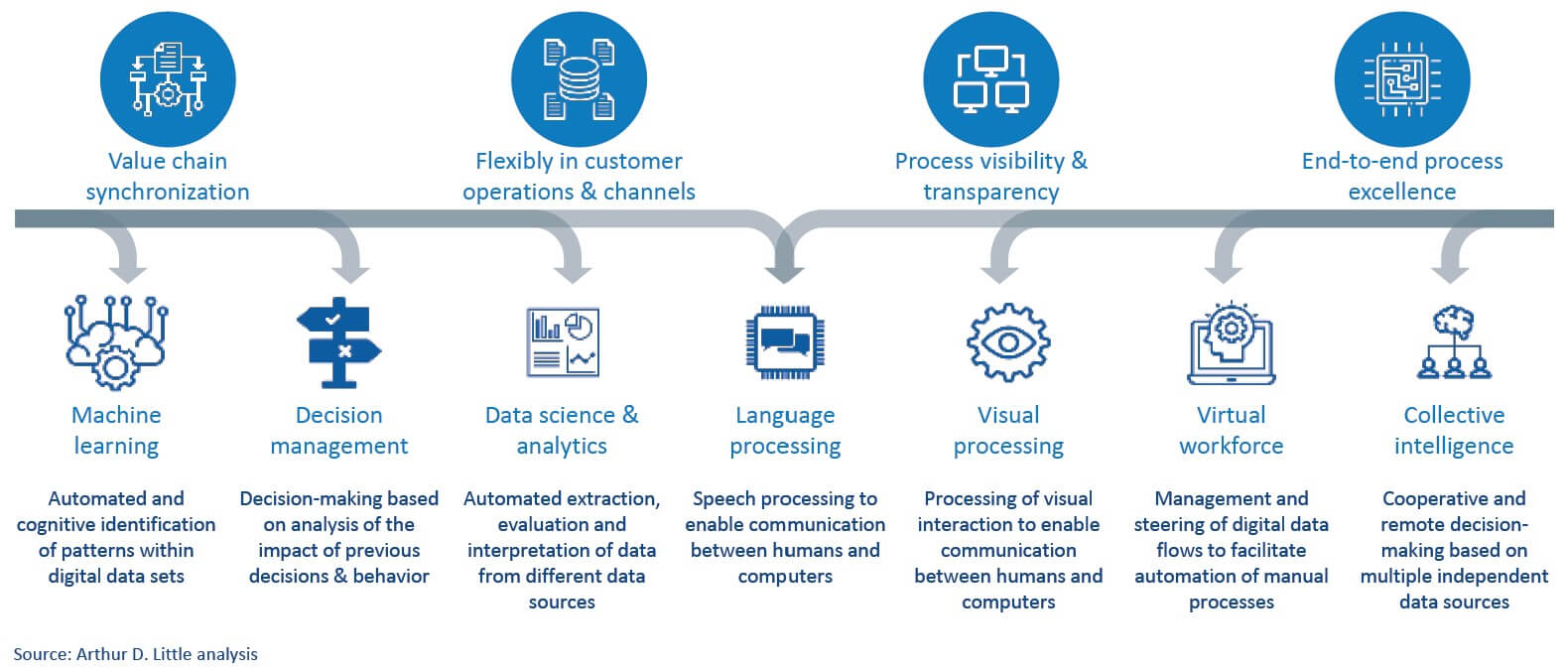
Building a resilient 21st century supply chain requires bold steps on four main fronts:
- Building agile networks: The ongoing pandemic has forced industries to step back and review their strategies, operations, and processes. Organizations have realized that they need to build networks and/or channels that will allow them to navigate quickly and easily in a changing environment. Building agile networks will require a flexible supply chain ecosystem with production spread across manufacturers. Organizations will have to build systems that can optimize costs, accelerate reaction times, and diversify channels. For networks to adapt quickly and function smoothly, it is also important to build agile teams willing to change and adapt rapidly to the external environment. Swift reaction to disruptions can hasten change and minimize damage. (See Figure 5 for details.)
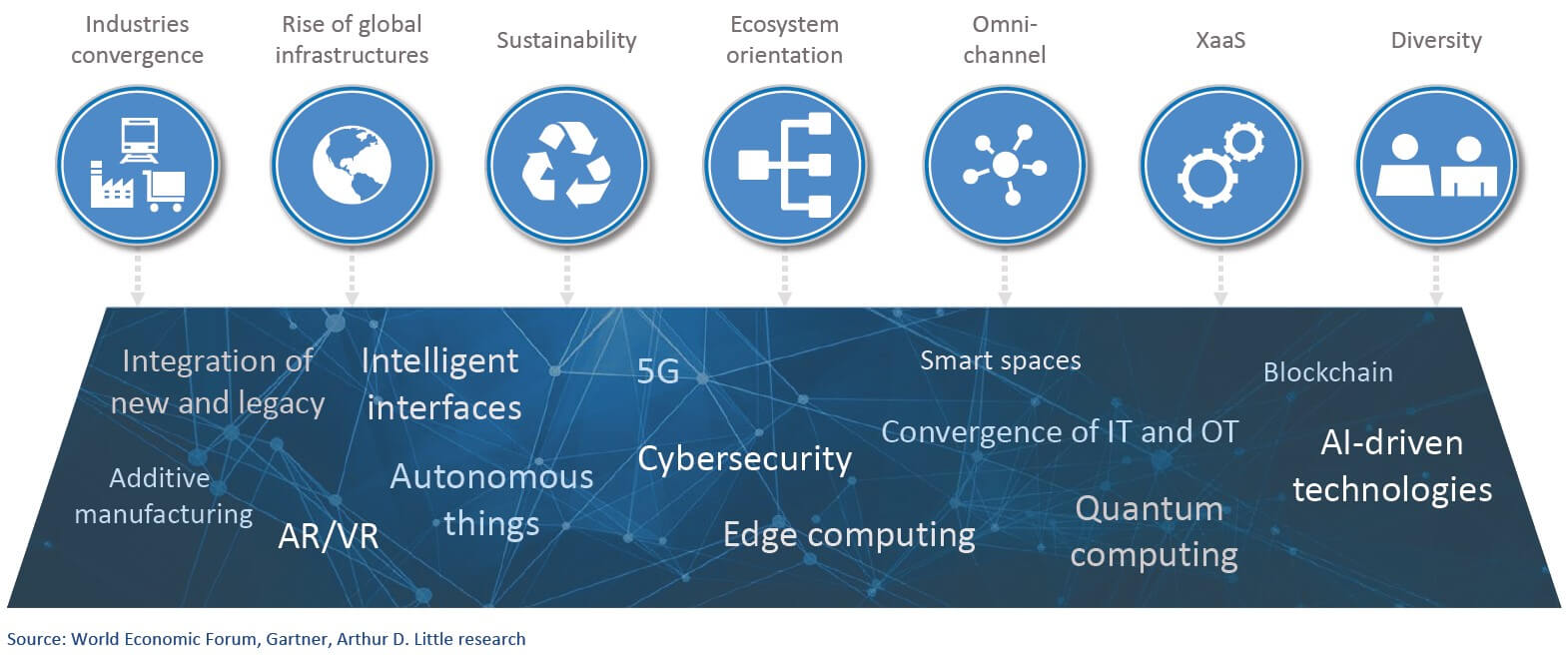
Recently, French and Italian production of disinfectants and medical gear proved insufficient to meet the needs of those combating COVID-19. Within 72 hours, LVMH’s perfume factories started producing hand sanitizers. Designer clothing factories of Giorgio Armani, Gucci, and Prada were producing medical overalls, and the trench-coat plant of Burberry began to make face masks and nonsurgical gowns. The supply chains’ flexibility to rapidly source raw materials and design, develop and test products and distribution played a key role in this switch.
- Digitization and use of disruptive technologies: Increased demand for e-commerce with a surge in online ordering has forced manufacturers and retailers to optimize their supply chain operations to deliver high volumes of packages directly to customers. A robust technological system such as blockchain technology for swift tracing of perishable items can boost the productivity of supply chains. The use of data analytics can ensure just-in-time deliveries. Digitizing the supply chain provides a collaborative platform for sharing information with stakeholders and managers at each point. This also raises the quality and speed of decision-making. There is a plethora of technologies that supply chains can use to their advantage. For example, Amazon uses drones for faster delivery and robots in its warehouses for inventory management. (See Figure 6 for more details, along with use cases.)
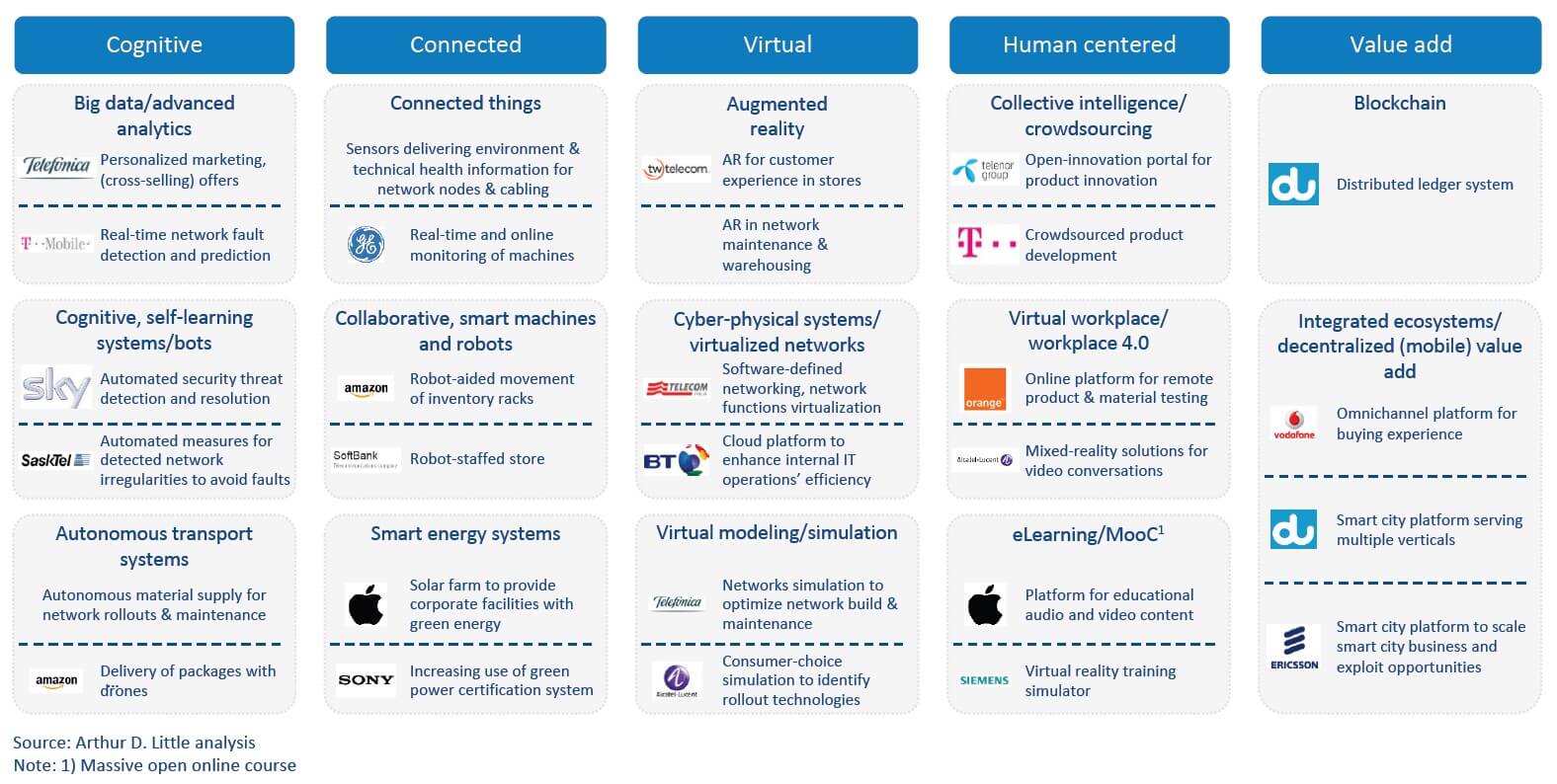
Among these, the trifecta of artificial intelligence, blockchain and the IoT is set to revolutionize the industry, with applications ranging from self-learning algorithms, data-based decision-making, real-time monitoring powered by the IoT, and sensor-based technologies. Blockchain also has a wide range of applications, from data management and secure transactions to traceability.
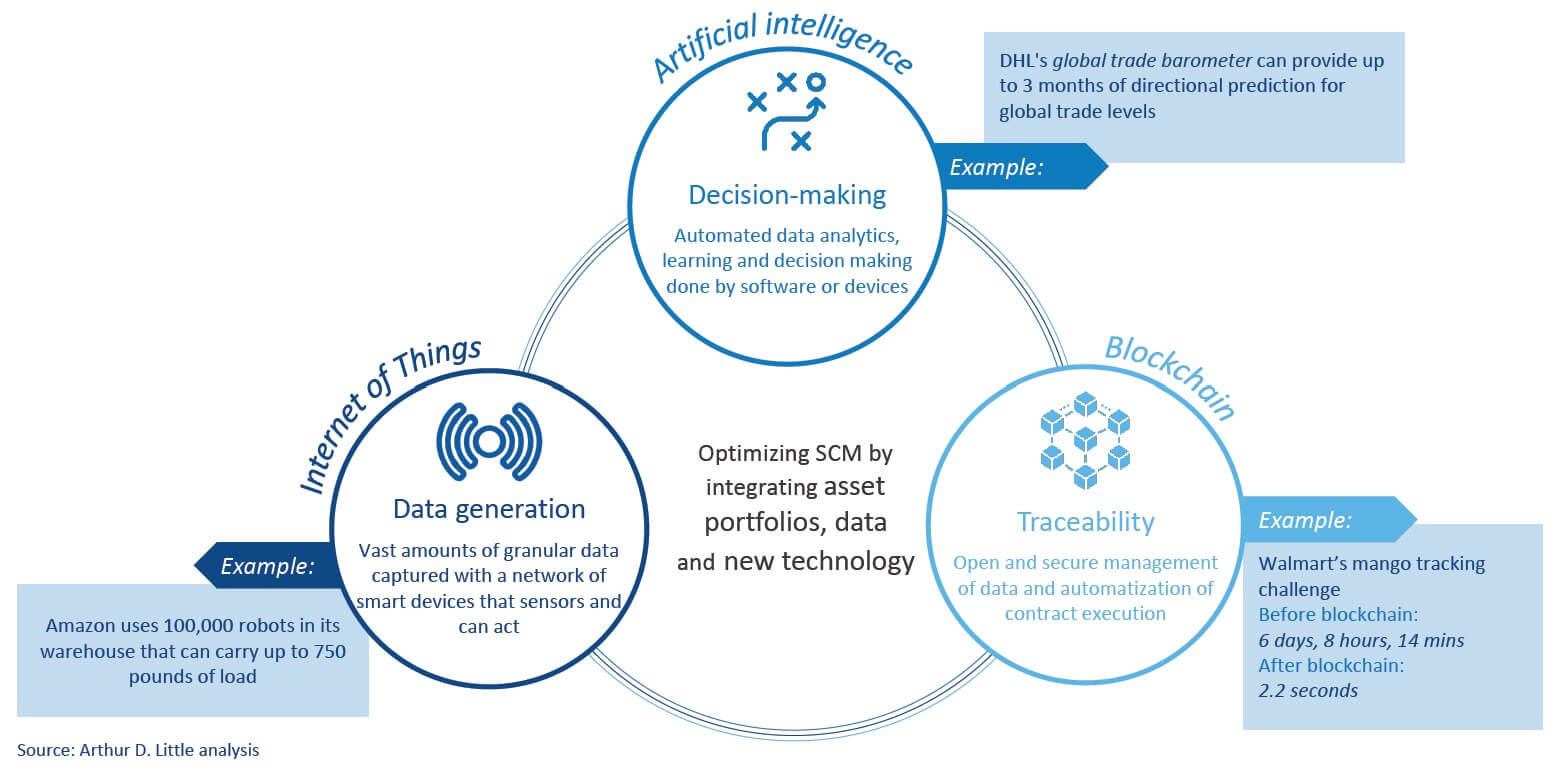
Procter & Gamble’s strategy to deploy a cloud-based platform for real-time information on production and external demand helped minimize the fallout when Hurricane Sandy hit New Jersey in 2012. The hurricane disrupted production in the P&G factory that made 91 percent of its perfumes. The use of advanced analytics and quick decision-making limited the plant’s downtime to two-and-a-half days. Further, in 2017, P&G used digital tools to predict which suppliers, plants and distribution centers were likely to suffer damage from Hurricane Irma in Florida. This allowed the company to prepare for contingencies and avoid disruption and financial loss.
- Ensuring end-to-end visibility: Visibility is an important factor in determining the supply chain system’s response rate. It enables manufacturers, distribution centers and retailers to respond quickly to the ebbs and flows of consumer demand, without the need for additional labor or resource allocation. For example, the panic-hoarding of toilet paper could have been avoided, had consumers been able to see the toilet-paper inventory level. Digitization of goods through radio frequency identification or barcodes will provide visibility at each step of the supply chain and help forecast demand and hence availability. Toyota has created a database to visualize the supply networks for each of its components. Thus, if a disaster strikes, the company knows precisely which parts are at risk. The database also identifies components that are provided by only one manufacturer and, hence, difficult to replace. This helps reduce dependency and arrange alternative suppliers.
- Moving from risk mitigation to risk management: Organizations were vulnerable to supply chain risks and disruptions much before the current crisis, to the point of losing millions of dollars. In a survey, approximately two-thirds of executives described their risks from supply chain disruptions and acknowledged that these continued to rise. The reasons ranged from lack of transparency in the supply chain to data restrictions, which made it difficult to ascertain the probability and severity of risks. Organizations should now take proactive roles in tackling these issues by structuring, cataloguing, and addressing known risks, and creating resilient systems to tackle unknown risks. As an example of managing known risks, they could mitigate supplier bankruptcy by maintaining supplier records and anticipating the disruptions that this could cause. Unknown risks can be managed by building strong defences, risk-aware cultures with speedy response teams, and systems that can help sustain shocks and provide competitive advantage. Moving from a reactive, experience-based system to a preventive analytical-based risk management system is important. It means using a range of mitigation measures that involve demand planning, supplier analytics, sourcing models, and partnerships.
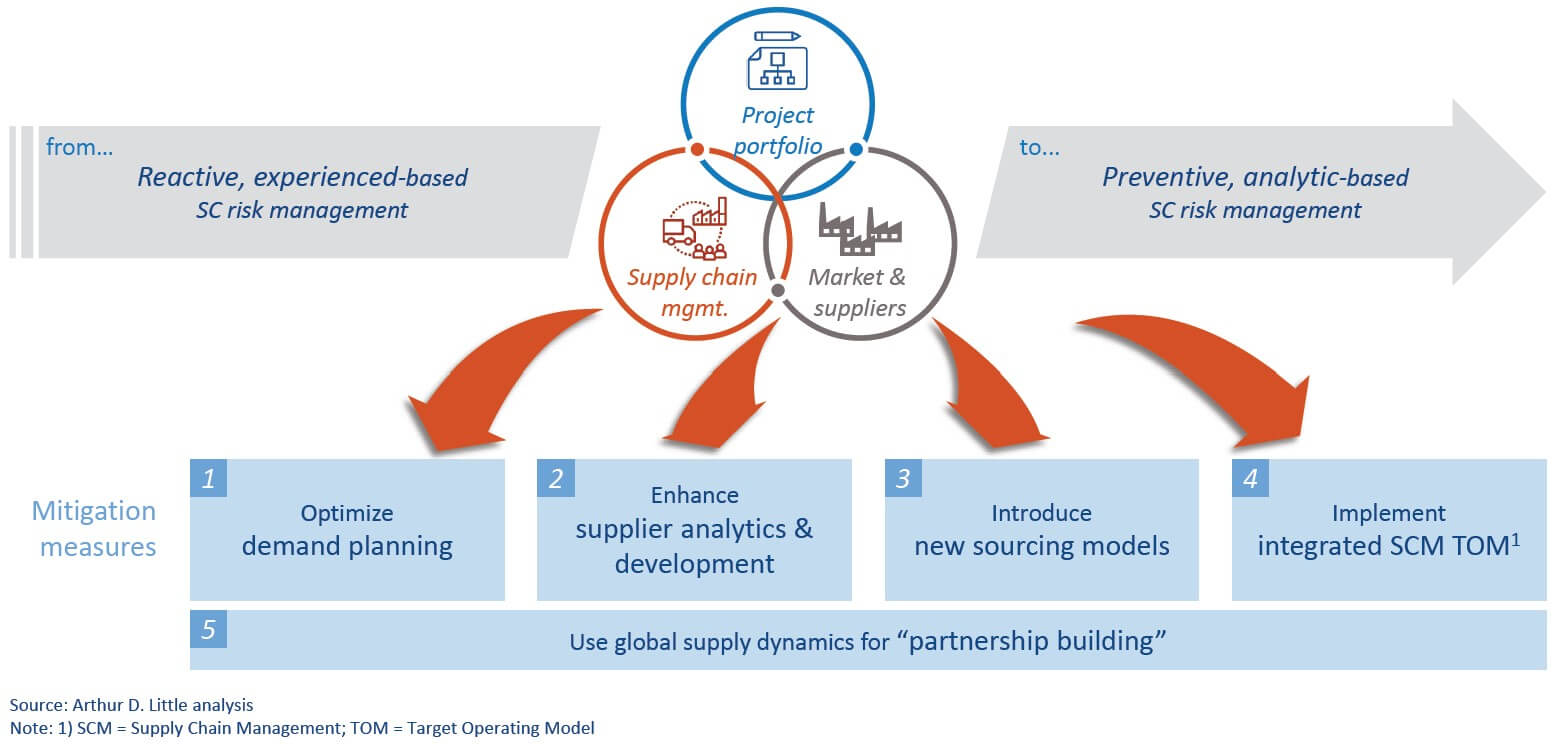
The common thread in these best practices is cutting-edge technology in the supply chain network, which can reduce operating expenditure to 30 percent. Further examples of technologically driven supply chains, provided below, prove the need for quick technology adoption in supply chain networks at all levels.
Amazon tests have shown that collaborative robotics can optimize costs by more than 25 percent by minimizing cycle times and building more efficient inventory management systems. Another example is the introduction of smart drone delivery services, which has reduced one-way delivery time and costs by up to 80 percent.
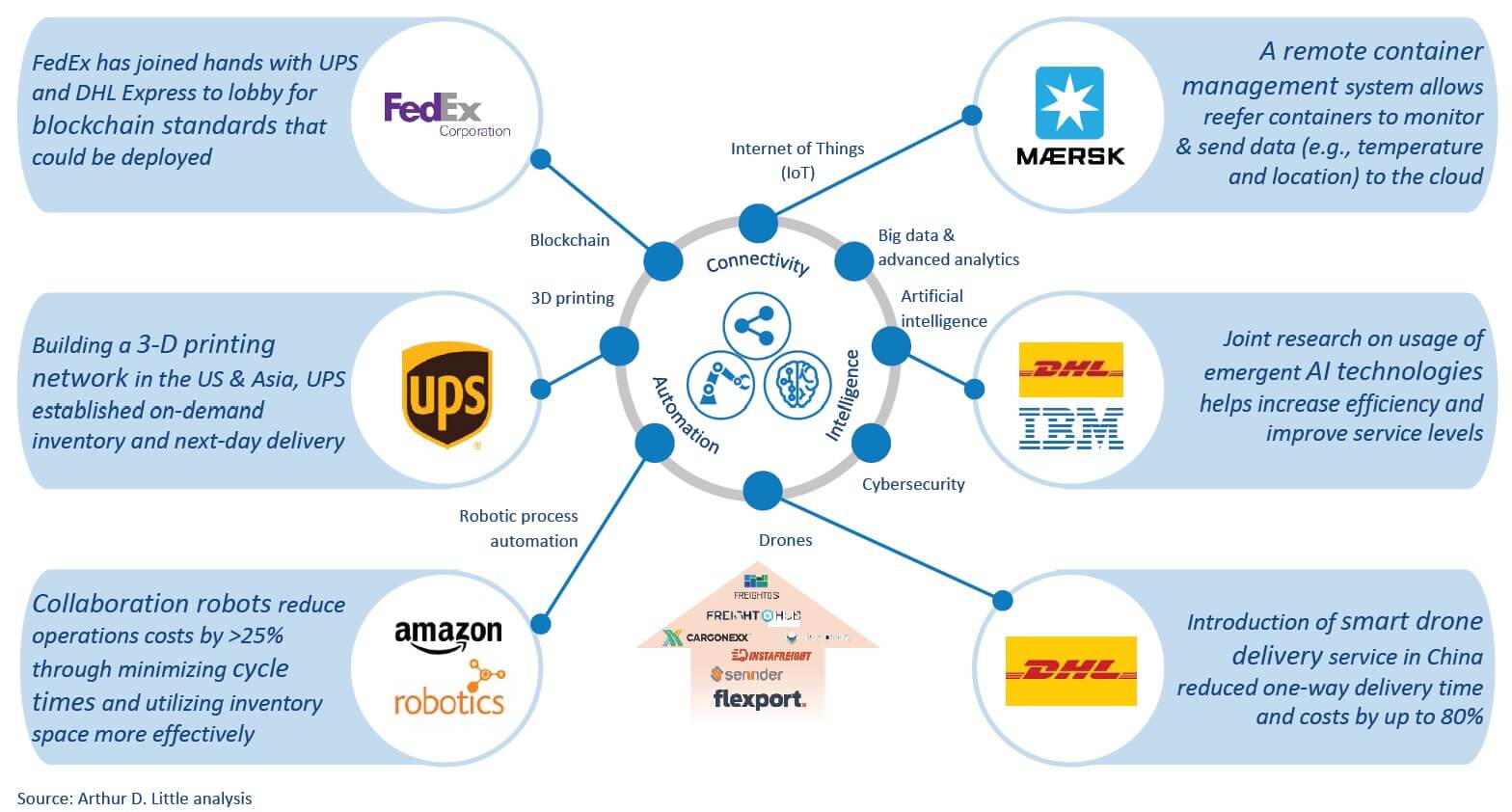
A few more examples across industries illustrate the tangible increase in competitiveness through the application of cutting-edge technology.
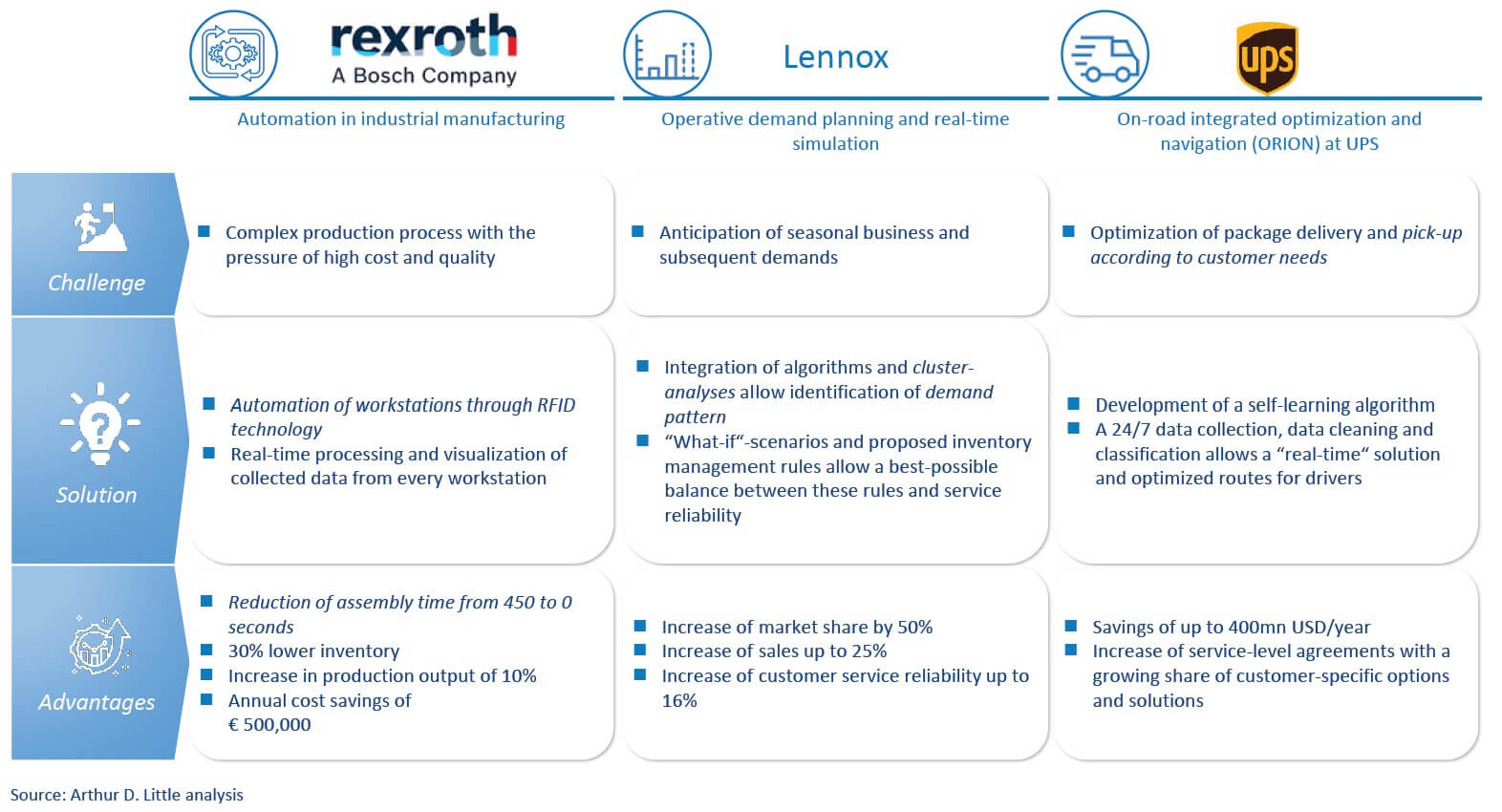
Rexroth, an industrial manufacturer with a product range of six different mobile hydraulics products at its plant in Homburg, had a very complex production line, which involved over 250 variations using more than 2,000 individual components. The demand required production in small batch sizes, which traditionally incurred a huge production and quality cost. Rexroth implemented RFID technology-based automation and collected, processed, and visualized real-time data from every workstation. This significantly shortened assembly time, reduced inventory by 30 percent, increased production output by 10 percent, and saved costs of up to 500,000 euros annually.
Lennox International Inc. is an intercontinental provider of climate-control products for the heating, ventilation, air conditioning, and refrigeration markets. The firm wanted to anticipate season-based demand patterns. Lennox implemented artificial intelligence-based operative demand planning, which used the integration of algorithms and cluster analysis to identify the demand patterns. This ensured high reliability and visible real-time availability of data, which improved the average forecast by 11 percent. This, in turn, increased sales by 25 percent and market share by 50 percent.
United Parcel Service (UPS), an American multinational package delivery and supply chain management company, implemented deep learning and machine learning for optimized transportation planning and navigation solutions. This involved a self-learning algorithm fed by traffic analysis data and customer-specific data, including other data like staff locations and weather information. The algorithm produced real-time smart and optimized routes for delivery and pick-up. Implementation of this technology saves approximately USD 400 million every year and enables a higher rate of meeting SLAs (service level agreements) and increased customer satisfaction.
Finally, Dubai’s Road and Transport Authority (RTA) is showcasing the “Future of Mobility 2030 and 2071”, which conveys that adoption of even driverless cargo transport might not be far away. RTA has created a plan for mobility/transport in the city for 2030 and beyond. According to the plan, transport and logistics will be very different from what we know today. Autonomous and connected transport will soon be common. Future vehicles will run on alternative fuels, reducing carbon emissions. Dubai has estimated a 50 percent reduction in the road/parking infrastructure in the next 10-15 years and a tripling of current road throughput.
These practices and applications have strategic implications for the supply chain in India, notably:
- Moving towards omni-channels, integrating general trade, including kirana stores: Omni-channels provide one-touch integration across all distribution channels, which leads to a seamless shopping experience. It efficiently addresses the gap between virtual sales (e.g., e-commerce websites and third-party channels such as Amazon) and in-store sales (e.g., kirana stores and retail chains), enabling customers to order from any channels of their choice. According to e-commerce players, a big shift towards virtual sales could increase India’s e-commerce market to around USD 85 billion by 2024. The e-commerce industry is projected to grow at 30 percent over the next five years. This will increase the gap between virtual and in-store sales.
- Building agile networks by simplifying the supply chain: Simplifying the supply chain and sourcing directly from manufacturers will reduce costs. Devising a plan and conducting pilots to supplement this change could help transform supply chains. Redesigning the supply chain will help adapt to newer ways of building a flexible system that will respond quickly to change. The just-in-time delivery system will need a robust supply chain well equipped with technology and automation. Incorporating these models requires agility in supply chain structures to ensure timely deliveries.
- Using the latest technology, particularly artificial intelligence, blockchain, and the IoT: Integrating physical networks with technology is the key to making supply chains sustainable. For example, the physical infrastructure in Amazon’s warehouse is designed according to the paths of the robots. For such transitions in the supply chain network, it is also important to focus on skill development at all levels of staff and leadership.
- Creating 21st-century multimodal logistics and warehousing: India should build the next-generation multimodal logistics system with a consolidated supply chain network using technology to ensure end-to-end visibility. This will require creating widespread availability of high-quality warehousing and cold-storage facilities to ensure smooth movement along the supply chain. The next-generation supply chain structure should be enabled by technology at all points.
- Shaping regulatory and policy support at the center and the state level: Government intervention will be required to ensure both widespread physical connectivity by building multimodal logistics and broadband connectivity to reach rural areas. Regulation can play a huge role in changing the manufacturing landscape through GST consolidation, supply chain clusters, and other such initiatives. The government’s support in creating a supply base through micro, small and medium enterprises (MSMEs) would ensure equitable economic growth and skill building.
COVID-19 has made us all aware of how vulnerable we are to disruptions in the supply chain. Transforming the system so it can contain risks and weather the crises of tomorrow is one of the main tasks before industry and government today.
3
Setting aspirations for transforming the supply chain: Vision 2030 for India
Making the Indian supply chain globally competitive requires nothing short of reimagining the entire system. This is a big opportunity for several sectors in India, including pharmaceuticals and consumer products. Sectors and organizations can decide their entry strategies, i.e., where in the business cycle it is more profitable and less risky to start or strengthen. The supply chain function will be required to play a more central and strategic decision-making role. As organizations get risk management strategies in place, the additional investment entailed will require a re-look at all elements of business processes and markers for profitable growth.
We propose the following Vision 2030 for the Indian supply chain:
“India will be one of the top 20 countries in the World Bank Logistics Performance Index by 2030. The supply chain industry will be an optimized and automated logistics ecosystem, with a simplified distribution system and a sustainable, green, resilient, and flexible supply chain. It will be powered by next-gen technologies such as big data, AI, blockchain, and Internet of Things, backed by 21st-century infrastructure. It will be aligned with best practices across the world and stand on par with global standards. The reimagined supply chain will make India “Atmanirbhar” and strongly complement Make in India and Startup India, building a globally competitive supply chain.”
To take concrete steps towards a sustained transformation of the supply chain system, we need to shape aspirations and catalyze holistic interventions as follows:
- Optimize the logistics and warehousing network: India will aim to reduce its logistics cost to 7-8 percent of GDP, closing the USD 500 billion competitiveness gap with best-practice countries. To this end, we will optimize the logistics modal mix to global benchmarks, with roads constituting 25-30 percent, railways comprising 50-55 percent, and waterways accounting for 20-25 percent of transportation modes. Transportation infrastructure will be efficient and fully utilized. We will also reduce indirect or “hidden” costs to 20-25 percent through efficient inventory management and monitoring. In addition, we will optimize turnaround time to 700-800 kilometers per day, with the target of increasing truck trips by 50 percent. We will also aim to increase the throughput of the road network by improving the quality of roads and increasing the proportion of national highways in the total road network. India will aim to increase the average speed of freight trains to 50 kmph and increase loading capacity and connectivity to industry. In warehousing, we will work to expand cold chain storage infrastructure to bridge the gap between required and available capacity and aim to reduce agricultural produce wastage to less than 10 percent. We will also seek to encourage private-public partnership (PPP) models to ensure faster progress in optimizing the logistics and warehousing networks.
- Faster adoption of cutting-edge technology: The Indian supply chain must be powered by next-gen technology and widespread Industry 4.0 applications to build technology-enabled smart supply chain networks. India will work towards digitization of more than 90 percent of data and strategic implementation of technologies such as artificial intelligence, blockchain, and the IoT. The supply chain will look towards machine learning and algorithm development for optimized demand planning and forecasting, to minimize inventory costs and eliminate wastage. Data-based decision-making will be the focus. Sensor-based monitoring, remote-controlled operations, and automation will be the most significant contributors to slashing costs and increasing operational efficiency, with the potential to reduce expenditure by 30-40 percent. Technology adoption will complement logistics efficiency by developing logistics maps with smart routing and ETA features for route optimization.
- Restructuring the supply chain: Indian supply chains will move towards building omni-channels as a one-stop solution that will reduce inventory levels and give customers a seamless shopping experience. We will also aspire to build an advanced platform that will facilitate collaborative planning. To ensure visibility, organizations will introduce harmonized product labels across the supply chain. Indian retail stores will adopt technology to leverage the potential of simplified supply chains. Brands will adopt new business models such as subscription schemes to predict demand patterns and click-and-collect to merge offline and online shopping experiences. Adidas, Reebok, and Max recently equipped their stores with “endless aisle” technology, which features iPads with which shoppers can browse and order items that are not in stock at the physical stores.
- Enhance skill development and talent management: With the rapidly changing times, senior management in organizations will aim to become more comfortable with digital transformation, data analytics, and AI. Organizations will bring in new talent and train existing staff to help them adopt changing technologies and faster decision-making. The focus will be on building skills for automation, the IoT, and data-driven decision-making to facilitate the transition to a technology-enabled supply chain. Organizations will also aspire to develop cross-functional teams to facilitate supply chain decision-making.
- Moving towards a green supply chain: Organizations will move towards greener modes of transportation to reduce carbon footprints by 50 percent. With e-commerce taking a significant share of the market, we will move towards using electric vehicles for deliveries and target a 50 percent electric fleet. Further optimizing transportation routes will create cleaner and more efficient supply chains. We will also work towards building an eco-friendly supply chain by using biodegradable or recyclable materials for deliveries and eliminating plastic to avoid environmental damage. In addition, we will reduce supply chain wastage (agricultural produce, food products, damages) by 50 percent. Organizations will practice the mantra of reduce, reuse, and recycle to build sustainable supply chains.
The goals and aspirations set out may seem unrealistic today, but with the right actions by industry and with enabling policy, India can achieve them. The CII Supply Chain Leadership Conclave laid the foundation for this discussion; the roadmap and the next steps to achieve Vision 2030, as described in the next chapter, will help realize these aspirations.
4
Roadmap and next steps for collaboration
This Vision 2030 report is the first step in achieving Vision 2030 for the Indian supply chain. In the next year, CII and Arthur D. Little will create a national supply chain task force comprising five working groups. These groups will interact regularly to discuss, plan, and execute initiatives that will help realize Vision 2030. CII will advocate for favorable policies with the state and central governments, and Arthur D. Little will provide technical expertise to scale up the initiatives undertaken by the groups. In 2021, we will also aim to unveil an action plan to achieve the set aspirations by 2030.
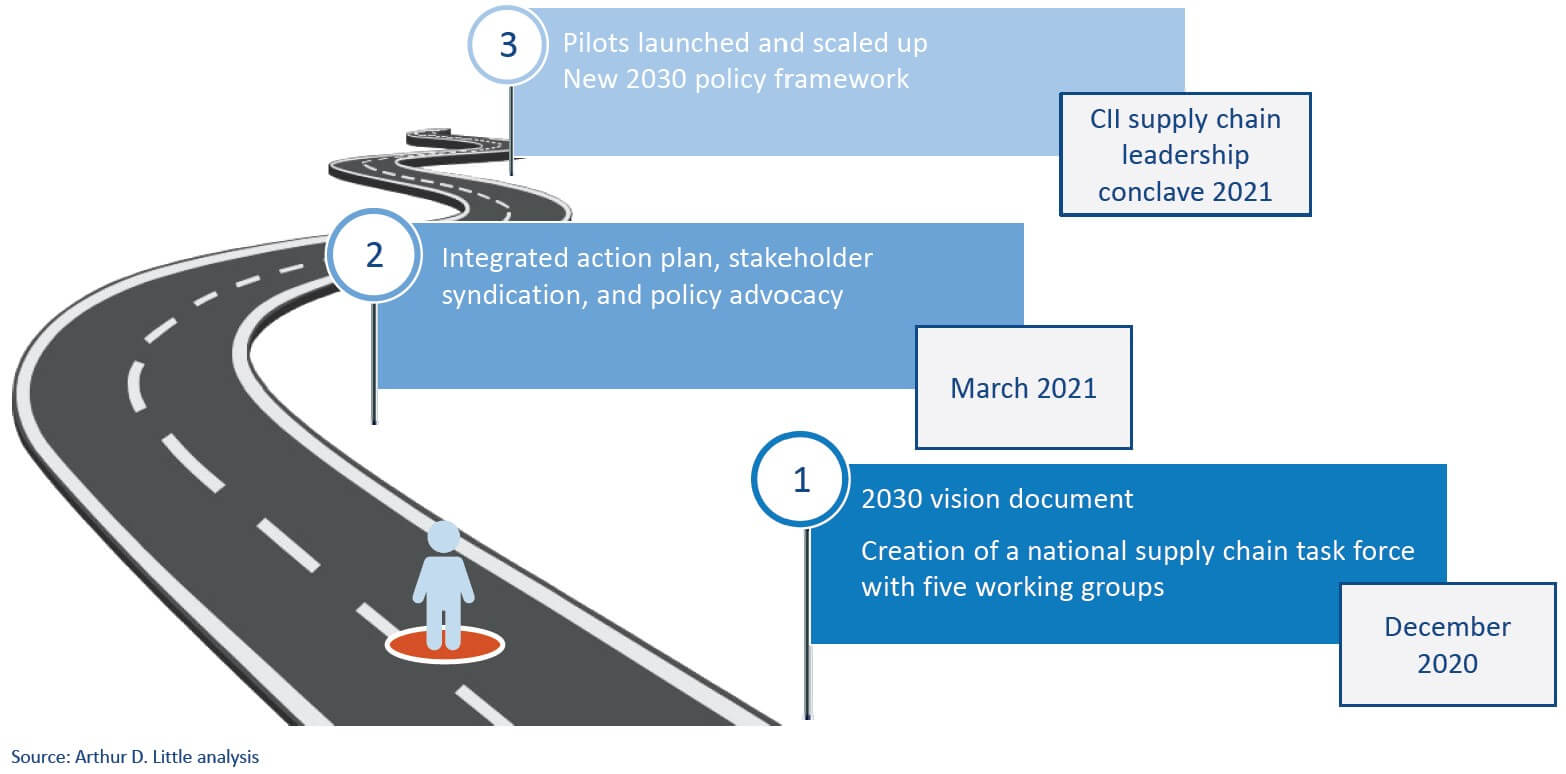
The supply chain leadership conclave highlighted the need to work on several fronts. First, we need to reduce logistics cost to 7-8 percent of GDP from the current 14 percent by bringing the logistics cost structure on par with global standards. (See Figure 12.) Logistics cost comprises transportation, warehousing, inventory, and order processing/admin, with indirect costs of yield losses, shrinkages, theft and damages, packaging costs, and more spread across these four cost divisions. Second, we need to de-layer the supply chain and move towards omni-channels, build a multimodal logistics system, and introduce the latest technology, including digitization, to move towards a 21st century supply chain.
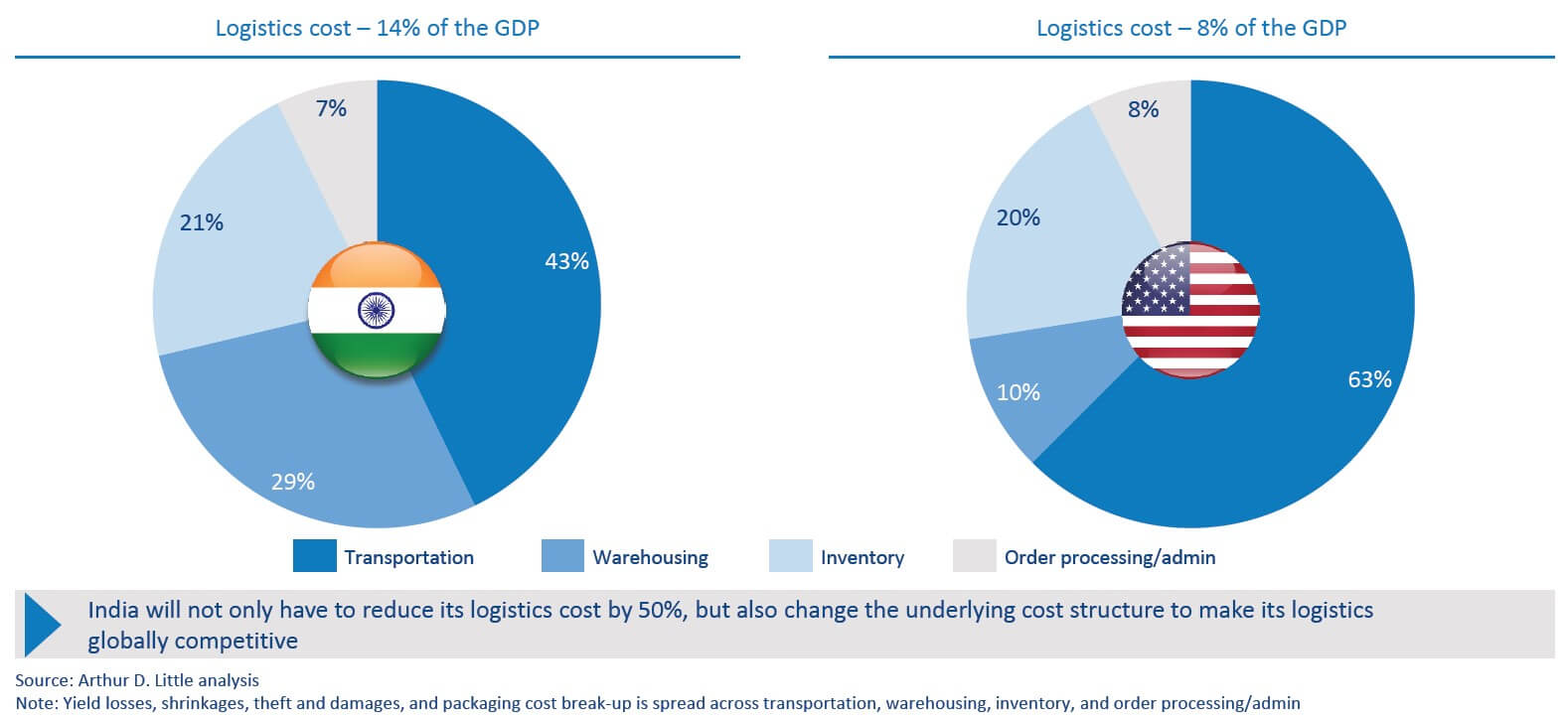
CII proposes creating five working groups, which will promote the execution of these measures across sectors. The groups will work in coordination with each other and industry members to truly realize the prime minister’s vision of “Atmanirbhar Bharat” by building a competitive supply chain network.
We propose three immediate steps:
- Setting up the national task force: CII will work on convening the national-level task force, which will be further divided into five working groups. These groups will comprise industry experts and work across sectors to gather suggested improvements in supply chain operations. CII will also help align supply chain priorities with the government and create access for working groups to exchange ideas. A supply chain expert from Arthur D. Little will be onboarded to help manage the initiative and facilitate interaction between working groups.
- Convening working groups: The working groups will be formed in keeping with various dimensions of supply chain excellence. They will work towards identifying relevant sectors of focus for a favorable policy push with the government. The working groups will also focus on the key actions needed to develop a competitive supply chain, as depicted in Figure 13. These groups will also work across relevant sectors, striving for policy advocacy and building sector-focused initiatives. (See Figure 14.) Hence, the working groups will follow an integrated vertical and horizontal structure. These groups will consist of six members each. They will meet regularly (monthly or quarterly) to plan initiatives, discuss execution, define governance and KPI monitoring systems, and review performance to scale up the initiatives. (See Figure 15.) The CII team will aid this process by engaging with the government on the points discussed in the groups.
- Developing an integrated plan of action: The aim is to develop a plan of action based on the findings, discussions, and suggestions of the working groups within one year of the groups’ formation. These plans should be actionable and have the potential for a quantifiable impact. The working groups can also consider a phase-wise plan. Ideally, the committees will launch pilot projects and eventually scale them based on success and experimentation.
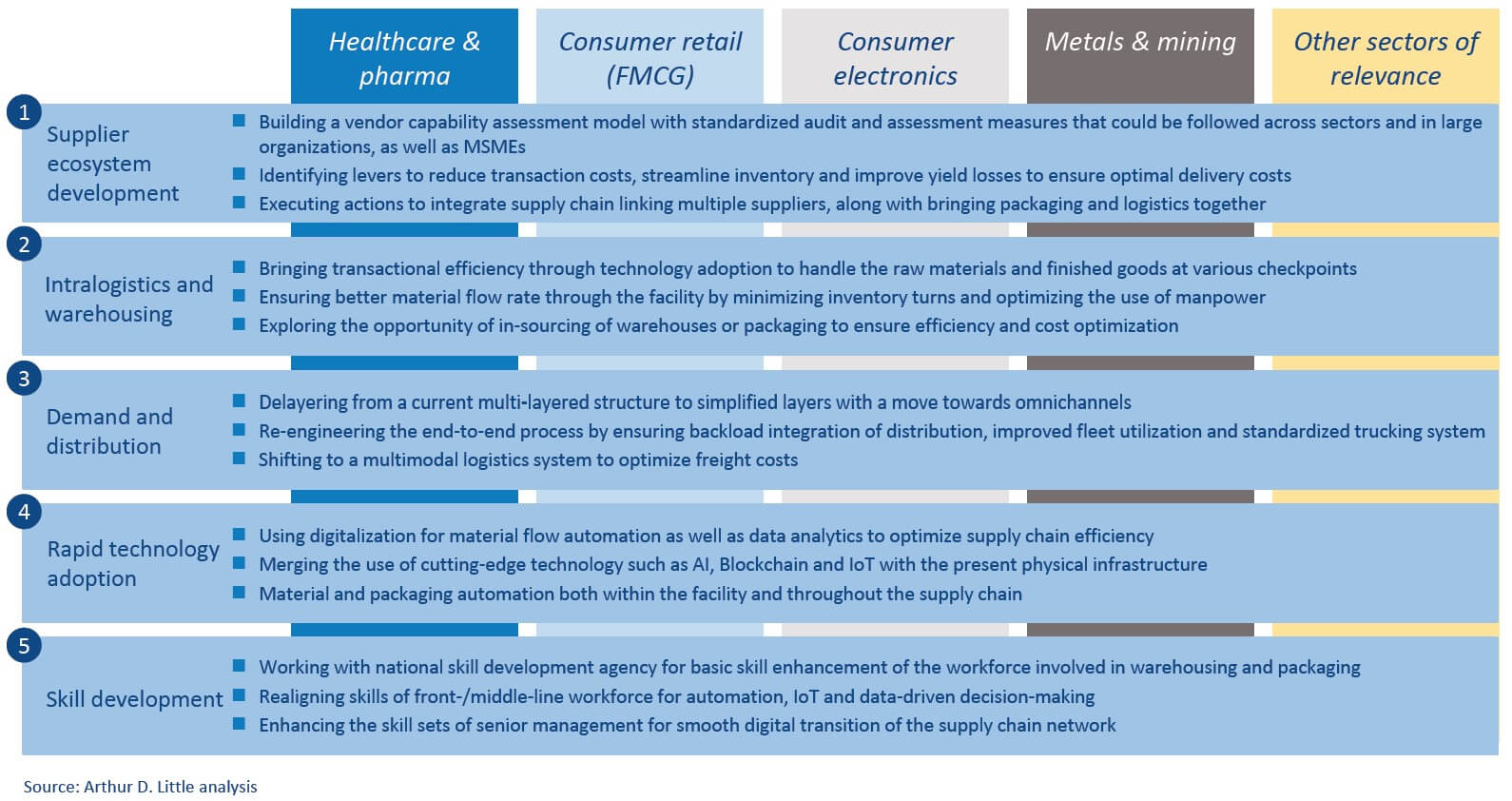
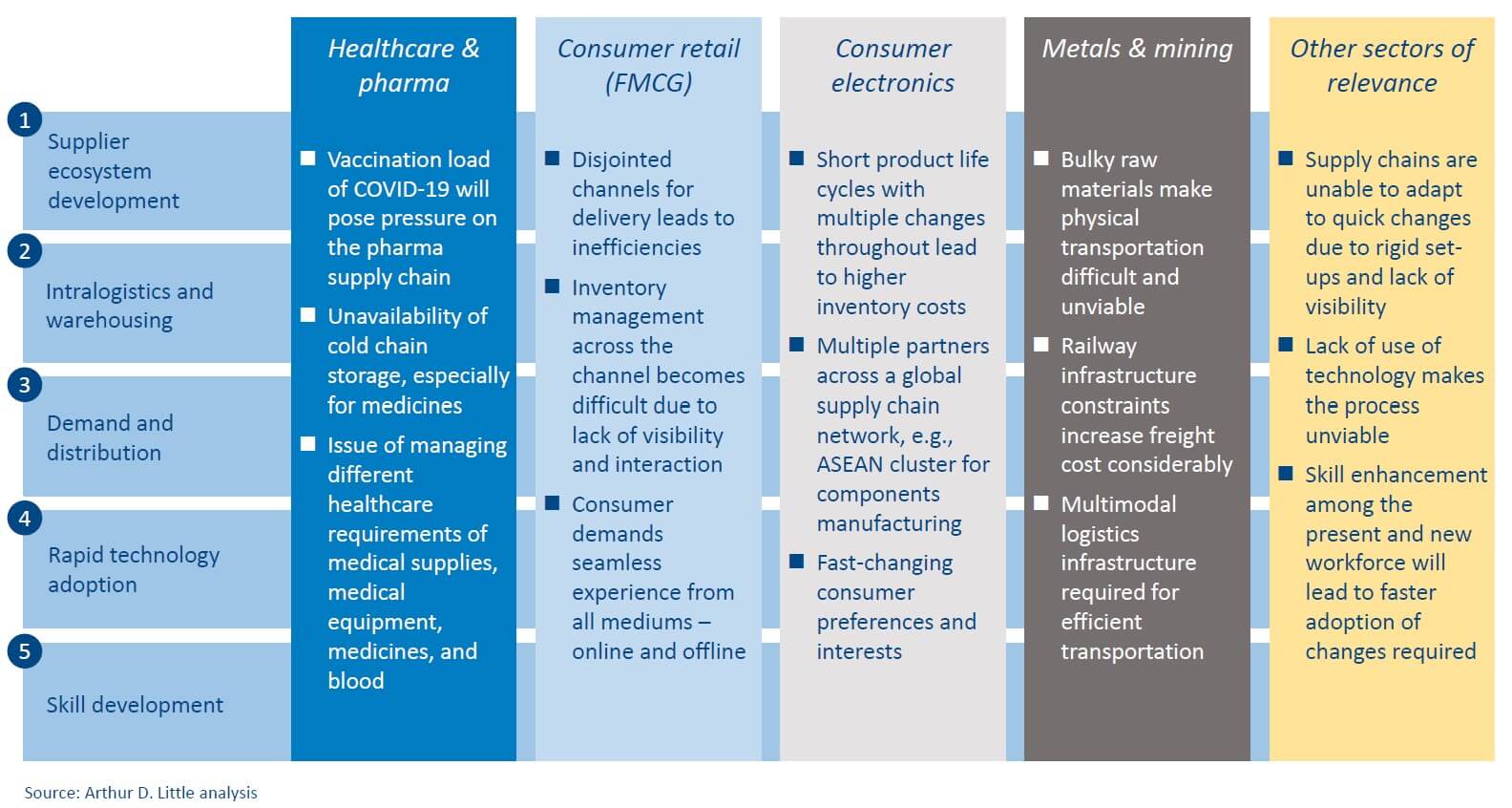
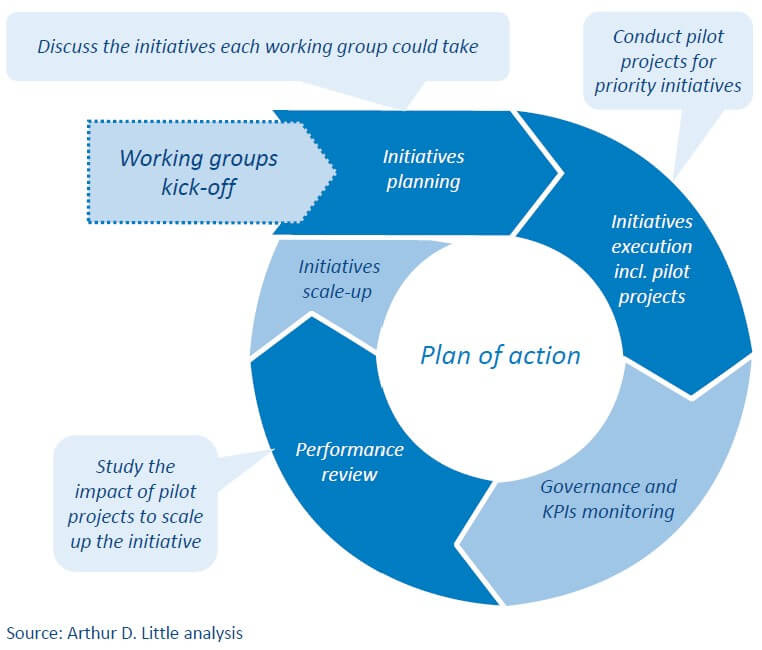
We hope that this report will provide the initial stepping-stone to achieving our aspirations for the Indian supply chain. Following the roadmap outlined above will give us the means and momentum to realize Vision 2030.
Note
[1] This is based on the expenditure method of GDP calculation.
DOWNLOAD THE FULL REPORT
26 min read • Organization & transformation, Strategy
Reimagining India’s supply chain
A bold vision for 2030

DATE

Foreword
India’s supply chain and logistics sector is one of the largest globally. The sector has the potential to grow multifold.
India needs to effectively bridge the competitiveness gap of USD 180 billion vis-à-vis the supply chains of advanced nations and become a leading player globally.
At the CII Supply Chain Leadership Conclave held on September 11, 2020, supply chain experts from the CPG and Pharmaceuticals presented their insights on the theme, “Supply Chain Transformation for Efficiency and Capability”. The conclave had the participation of over 270 delegates from the supply chain and logistics sector, including CEOs, Directors, experts and senior leadership of various organizations.
Deliberating on the scenario of India’s current supply chain, the Conclave discussed the need to build a technology-enabled, integrated supply chain that ensured visibility and efficiency and would create a flexible and agile process with seamless experience for customers.
To help achieve this goal, the report outlines a Vision 2030 for the Indian Supply Chain with focus on logistics costs, optimizing the logistics modal mix, digitizing 80-90% of supply chain operations, developing omni-channels and moving towards green supply chains. Enhancing skill development is also a key imperative.
The report has been developed by Confederation of Indian Industry (CII) and Arthur D. Little to set a bold ‘Vision 2030’ for the Indian supply chain and identify collaborative opportunities between Industry and State & Central Governments in achieving this vision.
We are certain that this report will help stakeholders build a globally competitive supply chain, thereby facilitating the transition for India’s evolution as a leading economy in the world.
— Mr CK Ranganathan, Deputy Chairman, CII Southern Region & Chairman & Managing Director, CavinKare Pvt. Ltd.
Preface and acknowledgements
The CII Supply Chain Leadership Conclave (CPG & Pharma), held on September 11, 2020, marked the beginning of an initiative to transform India’s supply chain in line with a bold vision for 2030. Arthur D. Little is pleased to be a part of this effort, starting with its role as CII’s technical partner for the conference.
This report describes the perspective gained through presentations by top supply chain experts and discussions with leaders in the industry. It aims to set the aspirations for the industry and lay down a roadmap to achieve Vision 2030.
We would like to acknowledge the insights and support provided by many in developing this report.
First of all, we are grateful for the unconditional support of CII Southern-Region for its help with coordinating and conducting the conference. We thank Jeanne Subramaniam for her editorial support.
Finally, we thank all the conference speakers for their expertise, commitment and generosity with time and information.
— Barnik Chitran Maitra, Managing Partner, India and South Asia, Arthur D. Little
Executive summary
It is hard to understate the importance of supply chain efficiency for large and growing economies, particularly India. An efficient and sustainable supply chain management system is one of the key factors for economic growth. An effective supply chain directly translates into competitiveness across economic sectors through lowered input costs.
India’s supply chain and logistics sector is one of the largest globally, with a logistics industry of USD 215 billion and growing at a CAGR of 10.5 percent. However, despite its size and criticality to economic growth, India’s supply chain is marred by an unbalanced logistics modal mix, high indirect costs, poor infrastructure, fragmented networks, and lack of technology adoption.
The COVID-19 pandemic has accentuated supply chain weaknesses, with nearly 75 percent of companies worldwide experiencing disruptions. Worse still, most companies have reported lack of any contingency plan to deal with a problem of this magnitude.
One of the biggest revelations of the pandemic for this sector is the urgent need to leverage disruptive technologies for greater resilience. In India, the pandemic has accelerated digital adoption on the demand side. This stemmed from the unprecedented demand faced by online grocery providers, which forced them to limit access for existing consumers in April and May 2020. These disruptive events pushed decision-makers to reimagine the country’s supply chain management.
This is the moment for the Indian supply chain and logistics sector to reconfigure and redesign supply chains with greater thought to disruptive technologies and risk management, especially considering the resilience required in the consumer-packaged goods (CPG) and pharmaceuticals sectors.
With this background, this report describes the key issues discussed at the CII Supply Chain Leadership Conclave held on September 11, 2020, and the steps needed to achieve Vision 2030 for the Indian supply chain. They can be summarized as follows:
- The logistics cost in India stands at 14 percent of GDP, compared to the global average of approximately 8 percent. This creates a competitiveness gap of USD 180 billion for India, which will increase to USD 500 billion by 2030.
- Supply chains are transforming globally by adopting Industry 4.0 trends. Organizations are building agile networks, using disruptive technologies, ensuring end-to-end visibility, and moving from risk mitigation to risk management.
- Several emerging technologies are available to enhance supply chain resilience. In mature economies, the use of artificial intelligence, blockchain, and the Internet of Things (IoT) has proved valuable.
- To make India’s supply chain competitive, efficient, and resilient, we propose a Vision 2030 that aims to pare logistics cost to 7-8 percent of GDP, optimize the logistics modal mix, digitalize 90 percent of supply chain operations, develop omni-channels, move towards green supply chains and enhance skill development.
1
An uncompetitive supply chain
The CII Supply Chain Leadership Conclave opened up a plethora of themes and ideas raised by supply chain experts in the CPG and pharmaceutical industries. The initiatives identified in their addresses match the imperatives for India in building a globally competitive supply chain.
Logistics costs in the Indian supply chain amount to almost USD 400 billion, or 14 percent of GDP.[1] A comparison with global peers shows that logistics costs amount to 8-10 percent of GDP in the US and Europe, and 9 percent in China. The global average is close to 8 percent of GDP, which reveals a competitiveness gap of USD 180 billion for India. India ranked 44 in the World Bank Logistics Performance Index, last released in 2018, far behind the US at 14 and China at 26. Other South-Asian countries, such as Thailand and Vietnam, also have high logistics costs. These countries’ costs reach 14 and 16-17 percent of GDP, respectively. However, they fare slightly better than India on the logistics performance index, with Thailand at 32 and Vietnam at 39.
Any improvement of India’s performance will hinge on how well we tackle barriers to competitiveness that impede the supply chain’s operation and growth.

Barriers to competitiveness
India’s supply chain has remained well below global standards because of the drawbacks and certain inefficiencies that plague it. These can be summarized as follows:
- An unbalanced logistics modal mix: A modal mix heavily skewed towards transportation by road is at the root of the unwarranted logistics costs. Transportation represents approximately 40 percent of logistics costs, which amount to 6 percent of GDP. Transportation by road makes up the lion’s share of this cost, at about 64 percent, followed by rail at 30 percent and waterway and air transport at 5 and 1 percent, respectively. This heavy dependence on the road networks, combined with poor transportation infrastructure, makes transportation costs balloon. Currently, the per-ton-km cost of transportation via the road network is almost double that of rail and waterways, at Rs 2.58/ton-km, compared to Rs 1.41/ton-km for rail and Rs 1.06/ton-km for waterways. India’s rail and sea network are highly under-utilized due to lack of supporting infrastructure.

- High indirect or “hidden” costs: Indirect logistics costs in India are four times the average of those in developed countries. The main reasons are excessive layers in distribution channels and inventory mismanagement. Inadequate demand forecasting due to lack of technology adoption leads to inventory mismanagement. It also leads to high inventory carrying costs, which include costs for holding and storing unsold goods. These costs alone amount to 15-25 percent of inventory costs (4-6 percent of total logistics costs), which amounts to USD 120 to 180 billion.

- Poor-quality infrastructure: India has the second-largest road network globally, which totals 5.5 million kilometers, yet national highways account for less than 2.7 percent of the total network. This puts a severe strain on the national highway network, which carries about 40 percent of the road traffic. India also has one of the largest rail networks in the world, spread over 1.2 lakh kilometers. However, the average speed of freight trains in India is 24-25 kmph, compared to 38-40 kmph for those in the US and China. Furthermore, India has a shortage of warehousing space. Storing of drugs and perishable consumer goods requires cold-storage facilities. As of 2019, India had a total cold-storage capacity of 226.7 lakh tons (lt), against the required capacity of 350 lt. According to the Indian Council of Food and Agriculture, 30 percent of agricultural produce goes to waste every year due to lack of cold chain infrastructure.
- Limited adoption of the latest technology: The slow adoption of supply chain technology, such as artificial intelligence, blockchain and the IoT, remains a major shortcoming. Organizations globally have adopted the latest technologies to ensure full visibility and real-time information on processes in the supply chain. Lack of digitization, inventory mismanagement and inaccurate demand predictions in the absence of technology contribute in large part to the competitiveness gap between India and its global peers.
- Fragmented logistics (trucking) network: Despite its centrality to economic growth, India’s logistics sector has remained fragmented and unregulated, comprising many local players and no national or regional players that can create end-to-end platforms. The trucking industry is especially unorganized, and marked by non-standard equipment such as pallets and truck dimensions. Only 10 percent of Indian truck operators own fleets above 25 trucks; most others are drivers with single trucks who rely on third parties to handle their orders. With no big players to control the market, businesses at entry level are at a cost disadvantage. The turnaround time for trucks in India is low, at less than 300 kilometers per day compared, to more than 700 kilometers per day in Europe and the US.
- Uneven channel mix for domestic retail and FMCG sales: India’s retail market is dominated by unorganized retail, which amounts to a massive 90 percent of total retail, comprising nearly 12 million kirana stores. Digital/e-commerce platforms account for a minuscule 2 percent of sales, and organized retail just 8 percent. In comparison, countries such as China and the US have much higher shares of organized retail and online sales. These shares reach 56 and 21 percent, respectively, for China, and 76 and 14 percent, respectively, for the US. With so many micro- and small-scale sellers and scattered, barely integrated pathways for moving products, the supply chain has become convoluted.
At the conclave, leaders and experts detailed the improvements needed to make India’s supply chain more competitive. These can be summarized as follows:
- Technology-enabled supply chain architecture: The discussion revolved around making supply chain channels technologically driven. In today’s world, digitization is not an option, but a necessity. We need end-to-end, real-time visibility to enable quick action in case of disruption. The entire supply chain needs to be connected by integrating physical networks with digital technology. The latest technology, such as geo-tagging, auto-capture, and big data, enables collaboration, better forecasting, and traceability along the network, which helps to monitor supply chains. Technology-enabled forecasting helps reduce wastage along the supply chain by allowing organizations to manage demand- and supply-side shocks. Artificial intelligence, blockchain technology, and the IoT will bring breakthrough productivity gains in the supply chain network. Industry stakeholders have already made vigorous attempts at full use of these technologies. Automation in packaging has helped industries reduce the workforce by 20-30 percent, which has curtailed losses due to labor migration. The push due to the pandemic has led to faster adoption of technology.
- Integrating the supply chain network: Building a flexible and agile supply chain requires platforms that integrate the processes involved. The panelists recommended a move towards omni-channel supply chains to provide a seamless experience for consumers, irrespective of the channels used. Simplifying the supply chain will also make it feasible for organizations to function with low inventory. The panelists also suggested a need to integrate supply chain planning with execution to ensure quick response to any disruptions. Organizations will gain from building partnerships of shared assets and services. This will help them reduce costs and create an ecosystem by developing collaborative platforms such as online B2B marketplaces. The norm is not start-ups versus incumbents anymore, but start-ups and incumbents. Kirana shops are a unique feature of the Indian supply chain. Integrating kirana stores digitally has massive savings potential in terms of both costs and time. Orders through e-kiranas can save up to 120 minutes of retailers’ ordering time, which can be used more productively in serving customers.
- Building logistics infrastructure: A major theme at the conclave was improving India’s logistics infrastructure by benchmarking the logistics modal mix and emphasizing the use of electric vehicles (EVs) for last-mile deliveries. Optimizing routes, delivery points, and networks can reduce product damage, which will lead to green supply chains.
- Advocating for enabling policy: The panelists proposed a push for advocating supply chain-friendly policies. Appropriate policy will help improve India’s logistics network and make it globally competitive. The panelists raised the issues of standardization of truck size, reduction in turnaround time, development of last-mile city logistics, and development of logistics parks, for example, by leasing land from government PSUs through the proposed new logistics policy. Panelists also discussed other policy initiatives, including faster approval for licenses, swifter permissions related to logistics, and ease in documentation.
Failing to address India’s competitiveness gap of USD 180 billion could expand it to USD 500 billion by 2030. Greenfield manufacturing will remain unviable because high logistics costs are a barrier to entry. High logistics costs will continue to impede local manufacturing and reduce demand for Indian products in the global markets. As the observations of leaders and experts show, India has no choice but to transform its supply chain if it aims to become one of the leading economies of the world. The next chapter describes the preferred approach to doing so.
2
International learnings and next steps to build a 21st century supply chain
Applications and technology of the Fourth Industrial Revolution, particularly big data, augmented reality, the IoT, and blockchain technology, have created the means to transform supply chains, including configuration, planning, processing, and logistics. Effectively applying these approaches can reduce operating costs by 40 percent, while building more resilient and flexible supply chain networks.
In light of these trends and of recent supply-and-demand shocks in the supply chain, decision-makers are considering new ways of doing businesses and bringing innovation into their planning and operations to build a sustainable and resilient supply chain.

Building a resilient 21st century supply chain requires bold steps on four main fronts:
- Building agile networks: The ongoing pandemic has forced industries to step back and review their strategies, operations, and processes. Organizations have realized that they need to build networks and/or channels that will allow them to navigate quickly and easily in a changing environment. Building agile networks will require a flexible supply chain ecosystem with production spread across manufacturers. Organizations will have to build systems that can optimize costs, accelerate reaction times, and diversify channels. For networks to adapt quickly and function smoothly, it is also important to build agile teams willing to change and adapt rapidly to the external environment. Swift reaction to disruptions can hasten change and minimize damage. (See Figure 5 for details.)

Recently, French and Italian production of disinfectants and medical gear proved insufficient to meet the needs of those combating COVID-19. Within 72 hours, LVMH’s perfume factories started producing hand sanitizers. Designer clothing factories of Giorgio Armani, Gucci, and Prada were producing medical overalls, and the trench-coat plant of Burberry began to make face masks and nonsurgical gowns. The supply chains’ flexibility to rapidly source raw materials and design, develop and test products and distribution played a key role in this switch.
- Digitization and use of disruptive technologies: Increased demand for e-commerce with a surge in online ordering has forced manufacturers and retailers to optimize their supply chain operations to deliver high volumes of packages directly to customers. A robust technological system such as blockchain technology for swift tracing of perishable items can boost the productivity of supply chains. The use of data analytics can ensure just-in-time deliveries. Digitizing the supply chain provides a collaborative platform for sharing information with stakeholders and managers at each point. This also raises the quality and speed of decision-making. There is a plethora of technologies that supply chains can use to their advantage. For example, Amazon uses drones for faster delivery and robots in its warehouses for inventory management. (See Figure 6 for more details, along with use cases.)

Among these, the trifecta of artificial intelligence, blockchain and the IoT is set to revolutionize the industry, with applications ranging from self-learning algorithms, data-based decision-making, real-time monitoring powered by the IoT, and sensor-based technologies. Blockchain also has a wide range of applications, from data management and secure transactions to traceability.

Procter & Gamble’s strategy to deploy a cloud-based platform for real-time information on production and external demand helped minimize the fallout when Hurricane Sandy hit New Jersey in 2012. The hurricane disrupted production in the P&G factory that made 91 percent of its perfumes. The use of advanced analytics and quick decision-making limited the plant’s downtime to two-and-a-half days. Further, in 2017, P&G used digital tools to predict which suppliers, plants and distribution centers were likely to suffer damage from Hurricane Irma in Florida. This allowed the company to prepare for contingencies and avoid disruption and financial loss.
- Ensuring end-to-end visibility: Visibility is an important factor in determining the supply chain system’s response rate. It enables manufacturers, distribution centers and retailers to respond quickly to the ebbs and flows of consumer demand, without the need for additional labor or resource allocation. For example, the panic-hoarding of toilet paper could have been avoided, had consumers been able to see the toilet-paper inventory level. Digitization of goods through radio frequency identification or barcodes will provide visibility at each step of the supply chain and help forecast demand and hence availability. Toyota has created a database to visualize the supply networks for each of its components. Thus, if a disaster strikes, the company knows precisely which parts are at risk. The database also identifies components that are provided by only one manufacturer and, hence, difficult to replace. This helps reduce dependency and arrange alternative suppliers.
- Moving from risk mitigation to risk management: Organizations were vulnerable to supply chain risks and disruptions much before the current crisis, to the point of losing millions of dollars. In a survey, approximately two-thirds of executives described their risks from supply chain disruptions and acknowledged that these continued to rise. The reasons ranged from lack of transparency in the supply chain to data restrictions, which made it difficult to ascertain the probability and severity of risks. Organizations should now take proactive roles in tackling these issues by structuring, cataloguing, and addressing known risks, and creating resilient systems to tackle unknown risks. As an example of managing known risks, they could mitigate supplier bankruptcy by maintaining supplier records and anticipating the disruptions that this could cause. Unknown risks can be managed by building strong defences, risk-aware cultures with speedy response teams, and systems that can help sustain shocks and provide competitive advantage. Moving from a reactive, experience-based system to a preventive analytical-based risk management system is important. It means using a range of mitigation measures that involve demand planning, supplier analytics, sourcing models, and partnerships.

The common thread in these best practices is cutting-edge technology in the supply chain network, which can reduce operating expenditure to 30 percent. Further examples of technologically driven supply chains, provided below, prove the need for quick technology adoption in supply chain networks at all levels.
Amazon tests have shown that collaborative robotics can optimize costs by more than 25 percent by minimizing cycle times and building more efficient inventory management systems. Another example is the introduction of smart drone delivery services, which has reduced one-way delivery time and costs by up to 80 percent.

A few more examples across industries illustrate the tangible increase in competitiveness through the application of cutting-edge technology.

Rexroth, an industrial manufacturer with a product range of six different mobile hydraulics products at its plant in Homburg, had a very complex production line, which involved over 250 variations using more than 2,000 individual components. The demand required production in small batch sizes, which traditionally incurred a huge production and quality cost. Rexroth implemented RFID technology-based automation and collected, processed, and visualized real-time data from every workstation. This significantly shortened assembly time, reduced inventory by 30 percent, increased production output by 10 percent, and saved costs of up to 500,000 euros annually.
Lennox International Inc. is an intercontinental provider of climate-control products for the heating, ventilation, air conditioning, and refrigeration markets. The firm wanted to anticipate season-based demand patterns. Lennox implemented artificial intelligence-based operative demand planning, which used the integration of algorithms and cluster analysis to identify the demand patterns. This ensured high reliability and visible real-time availability of data, which improved the average forecast by 11 percent. This, in turn, increased sales by 25 percent and market share by 50 percent.
United Parcel Service (UPS), an American multinational package delivery and supply chain management company, implemented deep learning and machine learning for optimized transportation planning and navigation solutions. This involved a self-learning algorithm fed by traffic analysis data and customer-specific data, including other data like staff locations and weather information. The algorithm produced real-time smart and optimized routes for delivery and pick-up. Implementation of this technology saves approximately USD 400 million every year and enables a higher rate of meeting SLAs (service level agreements) and increased customer satisfaction.
Finally, Dubai’s Road and Transport Authority (RTA) is showcasing the “Future of Mobility 2030 and 2071”, which conveys that adoption of even driverless cargo transport might not be far away. RTA has created a plan for mobility/transport in the city for 2030 and beyond. According to the plan, transport and logistics will be very different from what we know today. Autonomous and connected transport will soon be common. Future vehicles will run on alternative fuels, reducing carbon emissions. Dubai has estimated a 50 percent reduction in the road/parking infrastructure in the next 10-15 years and a tripling of current road throughput.
These practices and applications have strategic implications for the supply chain in India, notably:
- Moving towards omni-channels, integrating general trade, including kirana stores: Omni-channels provide one-touch integration across all distribution channels, which leads to a seamless shopping experience. It efficiently addresses the gap between virtual sales (e.g., e-commerce websites and third-party channels such as Amazon) and in-store sales (e.g., kirana stores and retail chains), enabling customers to order from any channels of their choice. According to e-commerce players, a big shift towards virtual sales could increase India’s e-commerce market to around USD 85 billion by 2024. The e-commerce industry is projected to grow at 30 percent over the next five years. This will increase the gap between virtual and in-store sales.
- Building agile networks by simplifying the supply chain: Simplifying the supply chain and sourcing directly from manufacturers will reduce costs. Devising a plan and conducting pilots to supplement this change could help transform supply chains. Redesigning the supply chain will help adapt to newer ways of building a flexible system that will respond quickly to change. The just-in-time delivery system will need a robust supply chain well equipped with technology and automation. Incorporating these models requires agility in supply chain structures to ensure timely deliveries.
- Using the latest technology, particularly artificial intelligence, blockchain, and the IoT: Integrating physical networks with technology is the key to making supply chains sustainable. For example, the physical infrastructure in Amazon’s warehouse is designed according to the paths of the robots. For such transitions in the supply chain network, it is also important to focus on skill development at all levels of staff and leadership.
- Creating 21st-century multimodal logistics and warehousing: India should build the next-generation multimodal logistics system with a consolidated supply chain network using technology to ensure end-to-end visibility. This will require creating widespread availability of high-quality warehousing and cold-storage facilities to ensure smooth movement along the supply chain. The next-generation supply chain structure should be enabled by technology at all points.
- Shaping regulatory and policy support at the center and the state level: Government intervention will be required to ensure both widespread physical connectivity by building multimodal logistics and broadband connectivity to reach rural areas. Regulation can play a huge role in changing the manufacturing landscape through GST consolidation, supply chain clusters, and other such initiatives. The government’s support in creating a supply base through micro, small and medium enterprises (MSMEs) would ensure equitable economic growth and skill building.
COVID-19 has made us all aware of how vulnerable we are to disruptions in the supply chain. Transforming the system so it can contain risks and weather the crises of tomorrow is one of the main tasks before industry and government today.
3
Setting aspirations for transforming the supply chain: Vision 2030 for India
Making the Indian supply chain globally competitive requires nothing short of reimagining the entire system. This is a big opportunity for several sectors in India, including pharmaceuticals and consumer products. Sectors and organizations can decide their entry strategies, i.e., where in the business cycle it is more profitable and less risky to start or strengthen. The supply chain function will be required to play a more central and strategic decision-making role. As organizations get risk management strategies in place, the additional investment entailed will require a re-look at all elements of business processes and markers for profitable growth.
We propose the following Vision 2030 for the Indian supply chain:
“India will be one of the top 20 countries in the World Bank Logistics Performance Index by 2030. The supply chain industry will be an optimized and automated logistics ecosystem, with a simplified distribution system and a sustainable, green, resilient, and flexible supply chain. It will be powered by next-gen technologies such as big data, AI, blockchain, and Internet of Things, backed by 21st-century infrastructure. It will be aligned with best practices across the world and stand on par with global standards. The reimagined supply chain will make India “Atmanirbhar” and strongly complement Make in India and Startup India, building a globally competitive supply chain.”
To take concrete steps towards a sustained transformation of the supply chain system, we need to shape aspirations and catalyze holistic interventions as follows:
- Optimize the logistics and warehousing network: India will aim to reduce its logistics cost to 7-8 percent of GDP, closing the USD 500 billion competitiveness gap with best-practice countries. To this end, we will optimize the logistics modal mix to global benchmarks, with roads constituting 25-30 percent, railways comprising 50-55 percent, and waterways accounting for 20-25 percent of transportation modes. Transportation infrastructure will be efficient and fully utilized. We will also reduce indirect or “hidden” costs to 20-25 percent through efficient inventory management and monitoring. In addition, we will optimize turnaround time to 700-800 kilometers per day, with the target of increasing truck trips by 50 percent. We will also aim to increase the throughput of the road network by improving the quality of roads and increasing the proportion of national highways in the total road network. India will aim to increase the average speed of freight trains to 50 kmph and increase loading capacity and connectivity to industry. In warehousing, we will work to expand cold chain storage infrastructure to bridge the gap between required and available capacity and aim to reduce agricultural produce wastage to less than 10 percent. We will also seek to encourage private-public partnership (PPP) models to ensure faster progress in optimizing the logistics and warehousing networks.
- Faster adoption of cutting-edge technology: The Indian supply chain must be powered by next-gen technology and widespread Industry 4.0 applications to build technology-enabled smart supply chain networks. India will work towards digitization of more than 90 percent of data and strategic implementation of technologies such as artificial intelligence, blockchain, and the IoT. The supply chain will look towards machine learning and algorithm development for optimized demand planning and forecasting, to minimize inventory costs and eliminate wastage. Data-based decision-making will be the focus. Sensor-based monitoring, remote-controlled operations, and automation will be the most significant contributors to slashing costs and increasing operational efficiency, with the potential to reduce expenditure by 30-40 percent. Technology adoption will complement logistics efficiency by developing logistics maps with smart routing and ETA features for route optimization.
- Restructuring the supply chain: Indian supply chains will move towards building omni-channels as a one-stop solution that will reduce inventory levels and give customers a seamless shopping experience. We will also aspire to build an advanced platform that will facilitate collaborative planning. To ensure visibility, organizations will introduce harmonized product labels across the supply chain. Indian retail stores will adopt technology to leverage the potential of simplified supply chains. Brands will adopt new business models such as subscription schemes to predict demand patterns and click-and-collect to merge offline and online shopping experiences. Adidas, Reebok, and Max recently equipped their stores with “endless aisle” technology, which features iPads with which shoppers can browse and order items that are not in stock at the physical stores.
- Enhance skill development and talent management: With the rapidly changing times, senior management in organizations will aim to become more comfortable with digital transformation, data analytics, and AI. Organizations will bring in new talent and train existing staff to help them adopt changing technologies and faster decision-making. The focus will be on building skills for automation, the IoT, and data-driven decision-making to facilitate the transition to a technology-enabled supply chain. Organizations will also aspire to develop cross-functional teams to facilitate supply chain decision-making.
- Moving towards a green supply chain: Organizations will move towards greener modes of transportation to reduce carbon footprints by 50 percent. With e-commerce taking a significant share of the market, we will move towards using electric vehicles for deliveries and target a 50 percent electric fleet. Further optimizing transportation routes will create cleaner and more efficient supply chains. We will also work towards building an eco-friendly supply chain by using biodegradable or recyclable materials for deliveries and eliminating plastic to avoid environmental damage. In addition, we will reduce supply chain wastage (agricultural produce, food products, damages) by 50 percent. Organizations will practice the mantra of reduce, reuse, and recycle to build sustainable supply chains.
The goals and aspirations set out may seem unrealistic today, but with the right actions by industry and with enabling policy, India can achieve them. The CII Supply Chain Leadership Conclave laid the foundation for this discussion; the roadmap and the next steps to achieve Vision 2030, as described in the next chapter, will help realize these aspirations.
4
Roadmap and next steps for collaboration
This Vision 2030 report is the first step in achieving Vision 2030 for the Indian supply chain. In the next year, CII and Arthur D. Little will create a national supply chain task force comprising five working groups. These groups will interact regularly to discuss, plan, and execute initiatives that will help realize Vision 2030. CII will advocate for favorable policies with the state and central governments, and Arthur D. Little will provide technical expertise to scale up the initiatives undertaken by the groups. In 2021, we will also aim to unveil an action plan to achieve the set aspirations by 2030.

The supply chain leadership conclave highlighted the need to work on several fronts. First, we need to reduce logistics cost to 7-8 percent of GDP from the current 14 percent by bringing the logistics cost structure on par with global standards. (See Figure 12.) Logistics cost comprises transportation, warehousing, inventory, and order processing/admin, with indirect costs of yield losses, shrinkages, theft and damages, packaging costs, and more spread across these four cost divisions. Second, we need to de-layer the supply chain and move towards omni-channels, build a multimodal logistics system, and introduce the latest technology, including digitization, to move towards a 21st century supply chain.

CII proposes creating five working groups, which will promote the execution of these measures across sectors. The groups will work in coordination with each other and industry members to truly realize the prime minister’s vision of “Atmanirbhar Bharat” by building a competitive supply chain network.
We propose three immediate steps:
- Setting up the national task force: CII will work on convening the national-level task force, which will be further divided into five working groups. These groups will comprise industry experts and work across sectors to gather suggested improvements in supply chain operations. CII will also help align supply chain priorities with the government and create access for working groups to exchange ideas. A supply chain expert from Arthur D. Little will be onboarded to help manage the initiative and facilitate interaction between working groups.
- Convening working groups: The working groups will be formed in keeping with various dimensions of supply chain excellence. They will work towards identifying relevant sectors of focus for a favorable policy push with the government. The working groups will also focus on the key actions needed to develop a competitive supply chain, as depicted in Figure 13. These groups will also work across relevant sectors, striving for policy advocacy and building sector-focused initiatives. (See Figure 14.) Hence, the working groups will follow an integrated vertical and horizontal structure. These groups will consist of six members each. They will meet regularly (monthly or quarterly) to plan initiatives, discuss execution, define governance and KPI monitoring systems, and review performance to scale up the initiatives. (See Figure 15.) The CII team will aid this process by engaging with the government on the points discussed in the groups.
- Developing an integrated plan of action: The aim is to develop a plan of action based on the findings, discussions, and suggestions of the working groups within one year of the groups’ formation. These plans should be actionable and have the potential for a quantifiable impact. The working groups can also consider a phase-wise plan. Ideally, the committees will launch pilot projects and eventually scale them based on success and experimentation.



We hope that this report will provide the initial stepping-stone to achieving our aspirations for the Indian supply chain. Following the roadmap outlined above will give us the means and momentum to realize Vision 2030.
Note
[1] This is based on the expenditure method of GDP calculation.


